
“I declare this world is so beautiful that I can hardly believe it exists.” — Emerson
TEDXBELLARMINEU | A NATIONAL PARK ODYSSEY | BELLARMINE PRE-LAW SPRING 2024


IT’S KNIGHT OUT
Hundreds of students, faculty and staff gathered in the Quad on April 8 to view the total solar eclipse. Louisville, which was just south of the path of totality, experienced 98.9% coverage of the sun.
Photo by Brendan J. Sullivan



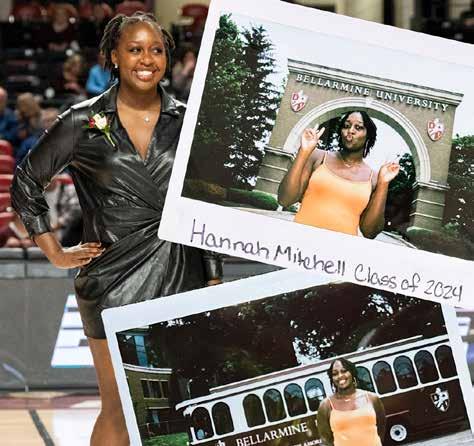
4 BELLARMINE MAGAZINE TOP 3 FROM THE LAST ISSUE Most-read content on www.bellarmine.edu/magazine Q&A with Alumni Board President
Winnie Shouse
Online Senior Administration Dr. Susan M. Donovan, President Dr. Sean Ryan, Senior Vice President Dr. Mark Wiegand, Vice President for Academic Affairs & Provost Dr. Helen-Grace Ryan, Vice President for Student Affairs Mr. Scott Self, Vice President for Development & Alumni Relations Dr. Michael Marshall, Vice President for Enrollment, Marketing & Communication Ms. Denise Brown-Cornelius, Vice President for Finance Bellarmine Magazine Staff Editor-in-Chief Carla Carlton Director of Communication for Advancement and Academics ccarlton@bellarmine.edu Managing Editor Amanda Lucas Director of Communication for Content Strategy alucas5@bellarmine.edu Photographer Brendan J. Sullivan Assistant Director of Communication for Photography & Video bsullivan2@bellarmine.edu Alumni Content Editor Jacob Gagel ’21/’22 MAC Assistant Director of Alumni Engagement jgagel@bellarmine.edu Designer Larry Jackson Contributors Austin Adam ’17, Dr. Jon Blandford ’00, Dr. Kate Bulinski, Harry Rothgerber Jr. ’69, Aili Whalen Printed by Clark and Riggs Printing Letters/Comments letters@bellarmine.edu | 502.272.8277 Bellarmine Magazine is published for and distributed to the alumni, parents and friends of Bellarmine University by the Office of University Communication. Bellarmine University 2001 Newburg Road Louisville, KY 40205 www.bellarmine.edu Hannah, a Criminal Justice Studies major with minors in French, Sociology, and African and African American Diaspora Studies, plans to go into non-profit work that serves those affected by the criminal-justice system. More about her and other Great Grads:
In Veritatis Amore Q&A with Emily Carroll ’08
https://tinyurl.com/Bellarmine24
COVER: This robin isn’t the only one who appreciates Bellarmine’s tree canopy. For the 10th consecutive year, the Arbor Day Foundation designated Bellarmine a Tree Campus USA in March 2024. Photo by Brendan J. Sullivan
THIS PAGE: Austin Adam ’17 shot this amazing photo in Alaska’s Katmai National Park. The Environmental Science graduate, who is now an environmental consultant in California, has visited all 63 U.S. National Parks. Story and more pictures, Page 32.

Moving in the Right Direction
The nation’s first fellowship in neurologic PT is the latest collaboration between Bellarmine and Norton Healthcare
Austin Adam’s Big Adventure
National Park odyssey, from Alaska to American Samoa
Academic Spotlight: Pre-Law
Three grads, a faculty member and a student testify for Bellarmine’s program
SPRING 2024 5 CONTENTS SPRING 2024
FEATURES DEPARTMENTS 6 FROM THE PRESIDENT The power of serving the public good 7 THE READERS WRITE 8 NEWS ON THE HILL 19 POEM A Retelling of Icarus by Ariana Alvarado 22 SECRET LIFE Amanda Lucas, content strategist and musician 40 THE ALUMNI CORNER Q&A with Matt Real 42 CLASS NOTES 44 IN VERITATIS AMORE “Two ways of knowing” 20 Question & Answer
School Dean Diane Bruce 24 Bellarmine Magazine Book Club
Rubel
One That
Away? 26 TEDxBellarmineU A great idea that keeps on growing 30
Moby-Dick: The
Got
32
36
A
Dr. Susan M. Donovan l president@bellarmine.edu
‘The power of serving the public good’

BELLARMINE UNIVERSITY is a highly engaged community of teachers and learners, an inclusive environment where we provide a highly personalized pathway and intentional success plan for every student.
But we are also part of a larger community—Metro Louisville—and we take our responsibility to be a good neighbor, and a valuable community resource, very seriously.
Fitting our Catholic social justice mission, our responsibility to the community involves building an intentional, visible and symbiotic relationship with the city. Louisville’s businesses, corporations and non-profits provide fantastic learning opportunities for our students, who in turn enrich these businesses with their talent, ideas and energy.
In 2020, we created a Center for Community Engagement (CCE) to direct our collaborative efforts. Led by Dr. Liz Todd Byron ’20 Ph.D. and supported university wide, the CCE has created thriving partnerships through academic courses, extracurricular programs and university research.
I was thrilled in January to receive word that this work had received national recognition when Bellarmine achieved the Carnegie Elective Classification for Community Engagement. Bellarmine is one of only 368 universities in the nation to receive this distinction, and only the second private university in Kentucky to do so, along with Berea College.
Timothy Knowles, president of the Carnegie Foundation for the Advancement of Teaching, said the institutions that were recognized “exemplify the true spirit of the Carnegie endorsement and the power of serving the public good.”
In addition to launching the CCE, Bellarmine’s recent actions to strengthen community engagement include:
• Updating faculty rank and tenure processes to better support community-engaged teaching, scholarship and service;
• Creating an hour of academic credit that can be added to an existing course for 30 hours of related community engagement;
• Adopting a Bonner Leader program that allows students to apply their federal work study benefits through community partners such as Kentucky Refugee Ministries, Nazareth Home and Cabbage Patch;
• Designing strong programming that supports community engagement, such as the annual Knights in Action day of service for new students, Martin Luther King Jr. Week of Social Responsibility in January, and Alternative Spring Break trips focused on educational access, racial justice and access to basic human needs each February; and
• Providing grants to students who face financial barriers, making it possible for them to complete unpaid internship experiences with nonprofit and government entities.
Esha Khan, an undergraduate student majoring in Biology who has done work through the Center for Community Engagement with organizations such as Kentucky Refugee Ministries, said the experience has been transformative.
“I am forever grateful to have the platform to turn learning into action,” Esha says.
“The CCE has shaped my dedication to service, and I'm proud to be part of a university that values community engagement.
Upholding Bellarmine's social justice mission is both exciting, meaningful and crucial to creating a better tomorrow.”
I congratulate the Bellarmine community on its commitment to service and engagement, and I look forward to seeing the continued impact that our students, faculty and staff have on our Louisville home.
6 BELLARMINE MAGAZINE
LETTER FROM THE PRESIDENT
Memories of a friend and teammate
I saw in the fall edition of the Bellarmine Magazine that my longtime friend and teammate, Chris “Big Mo” Makowsky, was listed in the “In Memory” section. Upon reading, I felt compelled to write this in hopes that those in the Bellarmine community who didn’t know him now maybe can.

Chris attended Bellarmine from 1977 to 1981, earned a degree in Business Administration and was an instrumental member of the pitching staff. His nickname served him well. His size was intimidating to most, especially opposing hitters, and rightly so. He threw hard, and he was good!
Chris, Scott Oliver, Paul Olson ’82 and I were all pitchers and teammates playing under my brother, Al Burke ’72. The four of us grew up in Jeffersonville, played Little League together, went to Providence High School together, played summer baseball together and attended Bellarmine together. We were as close as friends could be. That friendship continued until Chris lost his long, hard battle with cancer in March 2023.
Big Mo’s size was also indicative of his big heart and caring mannerisms. Sometimes loud, often funny, he was a tremendously caring and loving person and someone you could always count on. He was truly a gentle giant.
Our Bellarmine days are some of my best memories. I smile just thinking about the games, the long road trips, the parties and hanging out at Check’s Café (sometimes a little too much!).
Big Mo will always be remembered. Rest in peace, my friend.
Kevin Burke ’84 Jeffersonville, Indiana
One Knight in Bangkok
Caring for Aging Relatives
I loved the last issue of Bellarmine Magazine! I enjoyed reading all the features, and one article stood out in particular: “How to Care for Your Aging Relatives” [From the Experts, Fall 2023].
Just mentioning this topic is important. I imagine by the time many adult children are forced to seriously think about elderly or end-of-life care, it could be too late. I certainly wasn't thinking about it before this article.
My parents are in their late sixties, both with health issues. Hopefully, they'll live for another 20 years or more, but I've seen plenty of family and neighbors whose minds deteriorate years before they pass. Hoping alone is no guarantee.
Caring for my aging parents isn't something I like to think about. I want them to stay healthy in mind and body forever, and it hurts knowing that isn't possible. What is possible is ensuring my family has a plan in place to help my parents live their best lives regardless of the obstacles aging may throw our way.
Tim Jones ’20 MBA
Louisville
Vroom, vroom
It was interesting to read about April Mohr volunteering in Formula One racing and all the different “jobs” she has learned [“April Mohr ’04: Working in the fast lane,” Fall 2023]. Great article!
Marilyn Seinmetz ’73
Louisville

On March 3, Bellarmine junior Ella Lucas had lunch with Joe ’68 and Angela ’69 (Petchara) Schmidt at the EmQuartier mall in Bangkok. Ella, a junior from Winchester, Ky., who is majoring in Communications with a minor in Marketing, spent the Spring 2024 semester in Thailand thanks to the Angela Petchara and Joseph W. Schmidt Exchange-Student Fund, a program between Bellarmine and Thammasat University. The Schmidts met at Bellarmine-Ursuline after a scholarship brought Angela Petchara from her native Thailand to Louisville. “Thailand has been at the top of my list of dream destinations for years,” Ella said. “I am very grateful for the Schmidts’ kindness.”
I just finished reading the article about April Mohr and wanted to let you know I thoroughly enjoyed it. That is amazing that an organization exists to get more women involved in motorsports. I really wish I had the time to reach out to April Mohr and get involved. Maybe when my kids are a little older. Thanks for a great read!
Kim (Baker) Fairchild ’11
Louisville
WRITE TO US Bellarmine Magazine Bellarmine University 2001 Newburg Rd., Louisville, KY 40205 letters@bellarmine.edu THE
READERS WRITE
SPRING 2024 7
Compiled by Carla Carlton

POWERFUL PARTNERSHIPS
NEWS ON THE HILL
Photos by Brendan J. Sullivan
Bellarmine students who participated in an early campus arrival program in August 2023 volunteered at the Kentucky refugee ministries warehouse.

Bellarmine’s community service earns national notice
In January, Bellarmine achieved the prestigious Carnegie Elective Classification for Community Engagement from the Carnegie Foundation for the Advancement of Teaching, becoming one of only 368 universities in the nation to receive this distinction.
The national classification recognizes Bellarmine’s work over the past five years to build collaborative partnerships throughout Louisville and the surrounding region. Participating institutions must provide high-quality community engagement experiences that connect with classroom learning and deliver measurable outcomes for students and the community.
“This work has enriched student learning opportunities and contributed to their sense of wellness and purpose,” said President Susan M. Donovan. “It has also reinforced Bellarmine’s longstanding commitment as a Catholic institution to serve ‘for and with’ those in greatest need in the community.”
Last year, Bellarmine students engaged in more than 20,000 hours of community service.
One organization to benefit from that engagement is Kentucky Refugee Ministries.
"We’re grateful for the strong partnership we enjoy with Bellarmine,” said Adrienne Eisenmenger, the organization’s family and youth services manager. “The ongoing investment the university has made into promoting community engagement has made a significant impact on our organization in terms of volunteers and internships, donated items for incoming refugee and immigrant students, and educational support services for our rising college students.”
Dr. Liz Todd Byron ’20 Ph.D., who coordinated the university’s Carnegie Classification application, leads Bellarmine’s Center for Community Engagement, which was created in 2020. Obtaining the classification was a specific goal identified in the university’s 2019 strategic plan, Tradition and Transformation. The Carnegie Classifications are the nation’s leading framework for categorizing and describing colleges and universities in the United States.
SPRING 2024 9
Alumnus’ $1.725 million gift will expand new Nurse Anesthesia program
A gift of $1.725 million from Dr. Mushtaque Juneja ’00 MBA, a Louisville anesthesiologist and entrepreneur, will provide premier facilities, state-of-theart equipment, and faculty and student support for Bellarmine’s new Doctor of Nursing Practice-Nurse Anesthesia (DNP-NA) program. The program will now be called the Bellarmine University Juneja Nurse Anesthesia Program.
The DNP-NA program was announced in December 2022 and accredited in early 2023. The 18 students in the initial group are in their second semester. The second group, which started in August, was increased to 20 after approximately 300 candidates expressed interest.
Juneja is a founding member of Bellarmine’s Rubel School of Business Executive Advisory Board. He and his wife, Dr. Samina Juneja, are longtime supporters of Bellarmine. They made the construction of the Ponte Juneja Bridge on Via Cassia Road possible and named the Eva Vivienne Juneja Study Room in memory of their granddaughter.
Mushtaque Juneja said the future of the DNP-NA program is bright because there is a growing national shortage of anesthesiologists. “Bellarmine has a big opportunity to expand in this area, no question.”
For more information and to apply, visit the Doctor of Nursing PracticeNurse Anesthesia page.

Lansings become largest family donors in Bellarmine history

A $3.6 million gift from the estate of Dr. Allan and Donna Lansing to Bellarmine University brings the family’s lifetime giving total to more than $10 million, making the Lansings the largest individual donors in the university’s history.
The $3.6 million gift is earmarked for nursing and allied health, the men’s basketball and baseball programs, the Clinical Recitation Initiative for Student Enrichment (RISE) program, and the Bellarmine Fund, which supports all students and overall academic excellence.
Dr. Lansing, an internationally renowned heart surgeon, was a longtime Bellarmine trustee. The university's Donna and Allan Lansing School of Nursing and Clinical Sciences is named for the couple in honor of their support of the Nursing Program. They established many substantial scholarship funds, including the Lansing Scholars Program.
“Bellarmine and Bellarmine students were always important to our parents,” said the Lansings' daughter Michele Lansing Flowers. “Our father was especially partial to the Nursing Program because he said he could never have done it without the nurses who cared for his patients 24/7. They were an integral part of patients’ recovery. He may have fixed his patients’ hearts, but the nurses made them whole again.”
Donna Lansing died in 2021, and Allan Lansing passed away in 2022. “Their generosity has changed the lives of countless students and patients throughout our city,” President Susan M. Donovan said, “and with this most recent gift, will continue to do so for many years to come.”
10 BELLARMINE MAGAZINE NEWS ON THE HILL
$500,000 gift to support militaryaffiliated students

A $500,000 gift from the Richard S. Reynolds Foundation will significantly advance Bellarmine’s goal to be one of the nation’s best private universities for veterans and military-affiliated students.
The bulk of the gift will support tuition-based scholarships. It will also provide housing support and specialized appropriate programming through Bellarmine’s Office of Military and Veteran Services (OMVS).
Richard S. “R.S.” Reynolds founded the United States Foil Company, later called Reynolds Metals Company, which provided aluminum for military use in World War II and introduced Reynolds Wrap. After his death in 1955, his widow, Julia Louise Reynolds, started the Reynolds Foundation, which has provided over $66 million in grants to causes such as education, the arts, health and the environment.
Randy Reynolds ’67, grandson of R.S. and Julia Reynolds, was a foundation trustee and helped secure the gift before his death in May. “The foundation is proud to support our military and veterans through scholarships at Bellarmine,” he said in December 2023. “Where would our nation be without our veterans?”
Visit https://www.bellarmine.edu/office-of-military-and-veteran-services/ for more information.
Dr. Mary Huff named national fellow
Dr. Mary Huff, the dean of Bellarmine’s College of Arts and Sciences, was named one of 17 2024 fellows of the American Society for Biochemistry and Molecular Biology (ASBMB) in March. The national honorific program recognizes scientists who have made outstanding contributions to the field through their research, teaching, mentoring or other forms of service.
Huff, a biochemist and professor of Biochemistry, is currently studying the effect of two carcinogens in cigarette smoke on lung cancer cell lines in collaboration with Dr. Carolyn Klinge at the University of Louisville Health Science Center.

She said that while she has a deep appreciation for research, she was drawn to the classroom setting for several reasons.
“Watching students grasp challenging concepts or even finding joy in their own learning journey is incredibly rewarding,” she said. “In addition, teaching gives me the opportunity to support students as they prepare for life beyond graduation. Building these relationships is truly the most gratifying aspect of teaching here.”
Music faculty perform on Grammywinning album
Adjunct music instructor Chris Kincaid, who was nominated for a 2024 Grammy Award in the Best Classical Instrumental Solo category along with the Louisville Orchestra, conductor Teddy Abrams and pianist Yuja Wang, had big plans for the statue.
“I joked that if I won, I’d put it on a chain and wear it around my neck everywhere I go,” he said.
Kincaid did receive the hardware when The American Project became the first Grammy Award-winning album in the Louisville Orchestra’s 87-year history. But he’s displaying it in his studio.
Six other faculty—assistant professor Stacy Simpson (trumpet) and adjunct instructors Jon Mueller (viola), Allison Olsen (cello), Karl Olsen (bass), Terry O’Mahoney (drums) and Craig Wagner ’93 (guitar)—and former full-time instructor Dave Clark (saxophone) played on the album, but only Kincaid, who was the audio engineer, received a physical award. “It’s on top of an old keyboard, nestled in with some of my favorite things.”
The Grammy highlights the quality of Bellarmine’s music instruction, President Susan M. Donovan said. “I’m so proud of our faculty’s impact on our students and the community.”

SPRING 2024 11 NEWS ON THE HILL
Partnerships open new graduate school pathways
Bellarmine’s new partnerships with Centre College and Transylvania University will help keep their graduating students in Kentucky as they pursue graduate school.
The collaboration offers students and alumni from both schools guaranteed graduate admission at Bellarmine and discounted tuition for many of its graduate programs, along with opportunities for scholarships and financial aid intended to help make graduate school affordable.
“These pathways are a win for eligible students and a win for the Commonwealth of Kentucky,” said Dr. Susan M. Donovan, Bellarmine’s president. “Because we know these students will be well-prepared for graduate school, we can offer them a streamlined path to pursue a variety of excellent and affordable advanced degrees without leaving the state. After they complete both of their degrees, they will be equipped for lives of leadership and service here in Kentucky.”
In addition to current and future graduates from the two institutions, Transylvania and Centre alumni are also eligible for guaranteed admission and discounted graduate school tuition at Bellarmine.
Bellarmine offers more than 30 graduate and accelerated second-degree programs.
Departmental collaboration blossoms in new greenhouse
With 400 square feet of floor space, nearly 200 square feet of steel-mesh tabletops and a 10-square-foot hydroponics table, Bellarmine’s new greenhouse will provide opportunities for collaboration between the Biology Department and the Department of Environmental Studies and for experiments that weren’t previously possible. It will also be a place to start seeds for the Bellarmine Farm.

The previous greenhouse, which was nearly 50 years old, was demolished.
The controlled environment and hydroponics table in the new space will allow for a broader array of studies and experimental designs, said Dr. Josef Jareczek ’12, assistant professor of Biology, who oversees the greenhouse. “The facility will allow for growth of plants used in classes, such as bonsai cuttings and fruits and flowers for detailed anatomical study.”
Environmental Science major Leia Staples, a Louisville senior, is using the greenhouse for a plant-growth experiment for her Honors thesis.
“My project deals with looking at how sunscreen pollutants affect cucurbit plants—the cucumber family,” she said. “I hope to find out if current levels of pollution should be a concern right now in human food.”

Bellarmine launches groundbreaking cannabis education certificates
Bellarmine’s new cannabis education certificate program is the first offered by a public or nonprofit Kentucky university. The non-credit program is a partnership between Bellarmine’s Center for Community and Professional Education and Green Flower, the industry leader in cannabis education.
The courses, which are open to anyone but are designed for entrepreneurs, agriculturalists, healthcare providers and legal professionals, are:
• The Business of Cannabis
• Cannabis Agriculture & Horticulture
• Cannabis Healthcare & Medicine
• Compliance and Risk Management
• Cannabis Product Development & Design
A state law adopted earlier this year will allow Kentuckians with severe medical conditions to use prescribed medical marijuana that can be grown and sold in Kentucky for medicinal purposes beginning on Jan. 1, 2025.
“Helping Kentuckians access the most upto-date knowledge and expertise in different aspects of this industry will ensure that our state is well-prepared to realize the full economic, workforce and consumer benefits associated with cannabis while assuring that the products comply with applicable standards,” said Dr. Mark Wiegand, vice president for academic affairs and provost.
Each certificate program costs $2,950 and is available through six-month online sessions. More information is available at https:// cannabiseducation.bellarmine.edu.
12 BELLARMINE MAGAZINE NEWS ON THE HILL

Bellarmine is a Bee Campus USA
For the first time, Bellarmine has been recognized by the Bee Campus USA program, which recognizes communities working to conserve native pollinators. Bee Campus USA is an initiative of the Xerces Society for Invertebrate Conservation, which is named for the Xerces blue (Glaucopsyche xerces), believed to be the first North American butterfly species to become extinct because of urban development.
“The program aspires to make people more PC—pollinator conscious, that is,” said Scott Hoffman Black, Xerces’ executive director. “If lots of individuals and communities begin planting native, pesticide-free flowering trees, shrubs and perennials, it will help to sustain many, many species of pollinators.”
At Bellarmine, “we’ve been adding native pollinator gardens, doing invasive-species removals and reducing mowing and pesticide spraying at the Bellarmine Farm,” said Dr. Kate Bulinski, associate professor of Geoscience in the Department of Environmental Studies and advisor to the Bellarmine Beekeeping Club, which was founded two years ago.
The club built and installed several hives for honeybees amid the farm’s fruit trees in the summer of 2022. While honeybees are good pollinators, they are not among the roughly 3,600 species of bees native to the United States—they were imported from Europe. So this year, students plan to construct native bee houses.
“Keeping honeybees is good for pollination, but promoting native bee and insect populations is better for biodiversity,” Bulinski said. “We do both.”
According to the Xerces Society, pollinators enable the reproduction of over 85 percent of all flowering plants and 67 percent of agricultural crops. Research has shown significant declines in native pollinator populations.
“I think it is important for Bellarmine to engage in beekeeping and the farm because we only have one Earth and need to do everything we can to keep it healthy for future generations,” said Averi Smith, a senior English major from Louisville who is vice president of the Beekeeping Club.

ENTER THE 2024 BELLARMINE MAGAZINE PHOTO CONTEST
Welcome to the 2024 Bellarmine Magazine Photo Contest! Send us your best work in these categories:
• Nature (this includes landscapes and photographs of animals, birds or aquatic life)
• Architecture/Cityscapes
• Faces (human only, please)
You may enter one photograph (blackand-white or color) in each of the three categories. First-place winners will receive $100 each. All winning photographs will be featured in the Fall 2024 issue of Bellarmine Magazine and online.
The deadline to enter is 11:59 p.m. Friday, July 5. For complete rules and how to enter, visit www.bellarmine.edu/photorules.
Questions? Email Editor-in-Chief Carla Carlton at ccarlton@bellarmine.edu.
SPRING 2024 13 NEWS ON THE HILL
Passages
 MAUREEN MCRAITH
MAUREEN MCRAITH
MCGOWAN, a gracious and spirited woman who oversaw Bellarmine’s tremendous growth from 1990 to 2016 with her husband, President Joseph J. McGowan, died Oct. 12, 2023, in New York. She was 78.
“She was a true partner with Jay, with everything that he did and everything that he developed,” said Madeline Abramson, wife of former Metro Mayor Jerry Abramson and Maureen McGowan’s first cousin. “I can't think of Jay without thinking of Maureen. And I think that kind of sums it up.”
The McGowans, who met when she was a student at St. Mary's College and he was a student at Notre Dame, arrived in Louisville in 1990 from New York City, where Dr. McGowan had served as vice president of student affairs and dean of students at Fordham University. He was Bellarmine’s third president and its longest-serving president to date.
Under his leadership, Bellarmine College became Bellarmine University—a name change that reflected the school’s growth from a “hidden gem” that educated a small number of mostly commuter students to a nationally recognized residential university.
Even as enrollment grew, Dr. McGowan insisted that Bellarmine never lose its personal touch—and Maureen McGowan helped to make it feel like a home. She and Dr. McGowan created a sense of true community on campus and off, welcoming students and parents to the university and the President’s House.
“She was one of the kindest, warmest people I've ever known. And I don't say that just because she's my cousin,” Abramson said.
Their mothers were two of nine children. Maureen’s mother was the only one who didn’t raise her family in Louisville; she and her husband moved to Evanston, Ill., before Maureen was born. “So, I grew up seeing her just occasionally when she would visit,” Abramson said. “I really got to know her during the 27 years that she and Jay were at Bellarmine. It was so joyful for her to connect with her family here.”
She also made a deep connection with the Bellarmine family. Maureen McGowan “loved Bellarmine every bit as much as Jay did,” Abramson said. “She loved the people, she loved the professors, she loved the staff, she loved the students. It was just such a wonderful experience for her.”
The McGowans entertained often at the President’s House in Glenview. Maureen McGowan was always the
consummate hostess, even if she arrived just a few minutes before the guests.
“A lot of people didn't realize how many years she was working full-time,” Abramson said. “She was the chief financial officer for Louisville Collegiate School. She would come into the back of the home in Glenview, run up the back stairs, change clothes and come down the front stairs to welcome guests. She would spend the evening entertaining on behalf of the university—but she never complained because she loved it.”
The McGowans also loved sports, particularly Bellarmine women's and men's basketball. “When we would go to Bellarmine games with them, Jay would get so nervous he would get up and leave,” Abramson said. “He would either be walking around the aisle behind the seat, or he would leave completely. Maureen stayed in her seat because she knew the referees might need some guidance, and she never hesitated to tell the referees exactly what she thought of a particular call.”
As former director of Planned Giving at Bellarmine, Joan Riggert spent a lot of time with Maureen McGowan at university events. “She made each and every guest feel welcome,” she said. “She was a lover of good food and conversation, was diplomatic and smart, and had a wonderful sense of humor.”
The McGowans’ twin sons, Joseph and Matthew ’99, were grown when ehe couple moved to Louisville. But Joseph said he could tell how much their time there meant to his parents.
“My mom was grateful for the life that she and my dad were able to create and share together in Louisville,” Joseph said. “She always loved the match between what Bellarmine needed at that time and the many gifts that Dad brought.”
Maureen was at home with her husband on the morning of March 1, 2016, when he died suddenly and peacefully of a pulmonary embolism at the age of 71. At his visitation in Knights Hall, she stood for hours as hundreds of people lined up to pay their respects—and true to form, she comforted them.
In 2017, Colleen Liebert, a longtime friend of the McGowans in Louisville, established the Dr. Joseph J. McGowan, Jr. and Maureen McRaith McGowan Endowed Scholarship to honor their joint contributions to the university.
“As much as I revered Jay, I know how important Maureen became to the university,” she said then. “Jay had the foresight—he knew where he was going and what he could accomplish—but Maureen was there making sure it all happened. She is the most gracious person that I have ever had the privilege of knowing.”
14 BELLARMINE MAGAZINE NEWS ON THE HILL

DAVID PAUL O’TOOLE, former Athletic Director and math professor at Bellarmine, died March 11. He was 88.
O’Toole, who earned a bachelor’s degree from the University of Louisville and a master’s from the U of L Speed School, served as a faculty member in the Mathematics Department at Bellarmine from 1959 to 1997 and was appointed Professor Emeritus of Mathematics in 1999. He was also Athletic Director from 1997 to 2002.
As chair of Mathematics for 17 years, he helped to develop Computer Science and Engineering programs and initiated the first Advanced College Placement Program in Math with St. Xavier, his high school alma mater, in 1971. He was a National Science Foundation Fellowship recipient from 1969 to 1971. He also served on Bellarmine’s Board of Trustees for four years.
O’Toole served as the faculty athletic representative for 31 years. In 2022, he was inducted into the Bellarmine Athletics Hall of Fame.
"Dave was recognized as not only an outstanding member of the Bellarmine community, but the of the city of Louisville," said Bellarmine Athletic Director Scott Wiegandt. "His presence on campus and his leadership among our students, student-athletes, faculty, coaches and staff could never be duplicated."
O'Toole also played an integral part in the formation of the Great Lakes Valley Conference, Bellarmine's home from 1978 to 2020. He was the GLVC's first president and was inducted into the league's Hall of Fame in 2003.
In 2001, he was inducted into the Hall of Fame at St. Xavier, where he was an All-American swimmer in 1951, 1952 and 1953.

The REV. ISAAC MCDANIEL , a part-time Theology professor, died on Feb. 12 at age 74. McDaniel began teaching in Bellarmine’s Department of Theology and Religious Studies in 1999 and had a well-earned reputation as a knowledgeable, caring and openminded professor. His presence on campus for so many years was a reminder of the deep bonds between Bellarmine and the Archdiocese of Louisville, which he served faithfully. This semester, McDaniel had been teaching a section of Ultimate Questions and an IDC course.
A native of Owensboro, McDaniel graduated from Centre College and attended Saint Meinrad Seminary and School of Theology in Saint Meinrad, Ind., for major seminary. He was ordained a priest on May 2, 1982. He completed graduate studies at the University of Notre Dame, earning an M.A. in History in 1984 and a Ph.D. in History in 1991.
McDaniel was a monk of Saint Meinrad Archabbey from August 1976 until November 2002, when he incardinated into the Archdiocese of Louisville. Prior to serving the Archdiocese of Louisville and following ordination, he taught at Saint Meinrad Seminary and served as pastor at St. Isidore in Bristow, Ind., and Holy Cross in St. Croix, Ind. Following incardination, he served as associate pastor at St. Gabriel, part-time associate pastor at St. John Vianney and St. Jerome in Fairdale, Ky., and as sacramental moderator at St. Timothy, Our Lady Help of Christians and St. Patrick in West Point, Ky. He was also a faculty member at Spalding University.
The following alumni passed away between Sept. 1, 2023, and March 31, 2024.
Patricia S. Chervenak ’53
C. Lee Thompson ’54
C. Patrick Marguet ’55
Michael P. Coffey ’59
Charles V. Freville Jr. ’59
Ann S. Roina ’60
John F. Pfiester ’61
Samuel T. Hamilton ’62
K. Louisa Riehm ’62
Dr. Fred J. Stutzenberger ’62
James B. Schafer ’64
Dr. Robert L. Schweitzer ’64
William A. Burmester ’65
Kenneth R. Moakler ’65
William L. Willis ’65
David C. Hardin ’67
Thomas J. Mahoney ’67
Michael R. Heuser ’68
Thomas Sabo ’68
J. Bernard Backert ’69
William J. Ball Jr. ’69
Frank A. Schuff ’69
Donald H. Vish ’69
Judith M. Hildenbrand ’ 70
David A. Kinder ’70
George B. Rizer ’70
Joseph D. Mucci Sr. ’71, ’72, ’74
Beverly Ann Meschede ’72
Stephen W. Thim ’72
Sr. Anne M. Lochner ’73
Debra Tincher ’75
Mark Stephen Hanley ’76
H. Leon Shadowen ’76
Joe Allendorf ’78
Kathryn A. Hill ’79
Charles D. Mattingly Jr. ’79
James F. Feldkamp Jr. ’81
Sidney A. Swinney Jr. ’23 MBA
Sally R. Brady ’82
Charles R. Hufford Jr. ’85 MBA
Steve Miller ’86
Barbara Hale McCarty ’95 MSN
Stephen M. King ’95
Sarah Hubble Frazier ’97 MSN
Wendi Lea Schmetzer Johns ’04
Ian William Thomas ’07
Nicholas Joseph Kizinkiewicz ’08
Carl Eugene Jankowski ’12
Rebecca Mae Scott ’12
SPRING 2024 15 NEWS ON THE HILL
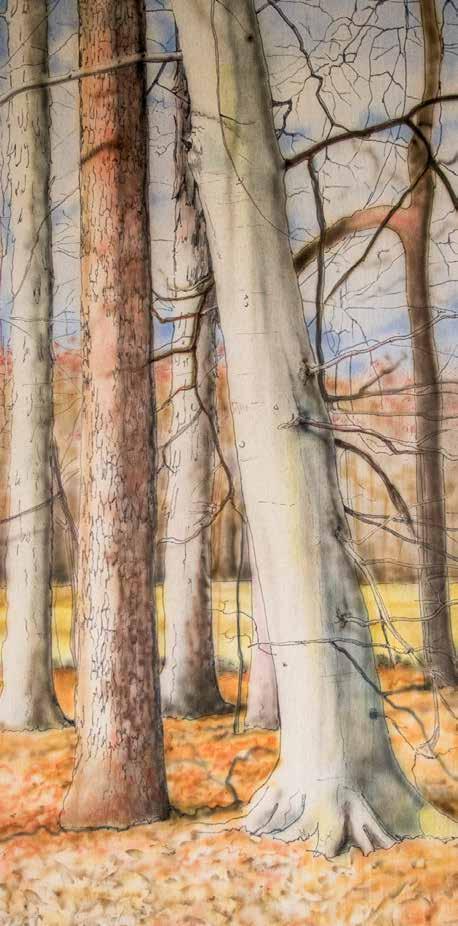
Bob Lockhart’s ‘Crème de la Crème’
“La Crème de la Crème” (“Best of the Best”), a recent show at Louisville’s Pyro Gallery, celebrated the wide influence of nationally recognized artist Bob Lockhart, the founder of Bellarmine’s Art Department.
The show featured work by 24 of his previous students at Bellarmine and elsewhere, along with ceramics by Fong Choo, Bellarmine artist-in-residence, and drawings by Lockhart.
After being hired as an art teacher at Ursuline College in the late 1960s, Lockhart came to Bellarmine, where he retired in 2011. “I said I was going to be a master artist, but I didn’t have what it took,” he said. “I didn’t know what I wanted to do. Then that nun hired me at Ursuline, and I found what I was meant to do—and that was to teach.”
Lockhart estimated he taught more than 7,000 students over 47 years. Choosing 24 to feature was difficult. “I was so proud to able to pay tribute to them,” he said. “It was humbling for me to see the incredible talent in this group.”
The Bellarmine alumni featured in the show were Ron Weis ’69, Dr. Rex P. Lagerstrom ’77, Loyola Walter ’80, Karen Terhune ’82, Mike McCarthy ’90, Mary T. Koester ’95, Jaime Corum ’96, Michael Ratterman ’96, Jason Kelty ’98, Shohei Katayama ’10, Peter Golemboski ’11, Nathaniel Hendrickson ’12 and Kayla Bischoff ’14.
“Bob was an incredible mentor and influence on not only my art but also my life,” Hendrickson said. “He taught me how to really see people. He also taught me about the importance of having an income to support my art habit. And, like Bob, I chose to begin a career as a teaching artist. I am currently serving as Drawing and Painting faculty at the Kentucky Governor’s School for the Arts and serve as a visiting assistant professor of Studio Art at Kentucky College of Art + Design here in Louisville.”
16 BELLARMINE MAGAZINE NEWS ON THE HILL
1
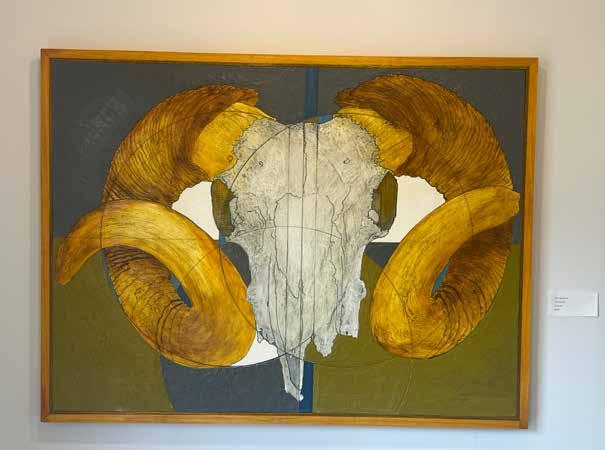

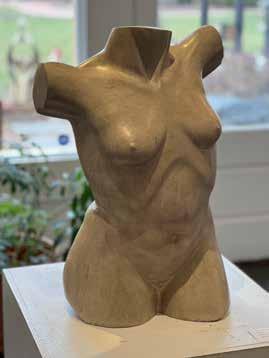



1. Nathaniel Hendrickson '12, “The Trees of Gethsemane, Kentucky”
2. Rex Lagerstrom '77, “Axis Mundi”
3. Dan Selter, “Portrait of Bob”
4. Bob Lockhart, “Drawing #13”
5. Karen Terhune '82, “Reclining Figure 2022-1”
6. Mike McCarthy '90, “Bust”
7. Fong Choo, “Sea Anemone”
SPRING 2024 17 2 3 5 4 6 7

KNIGHT OF EXCELLENCE
A New Tradition Recognizing Bellarmine University’s Best
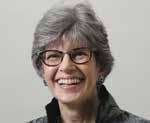

On Saturday, October 19, 2024, Bellarmine University will thank our President’s Society members, honor outstanding members of the Bellarmine community, and celebrate the importance of philanthropy to our mission at a new annual event: Knight of Excellence.
Knight of Excellence combines two previous signature Bellarmine occasions—Knight of Knights and the Alumni Awards—into one spectacular evening to thank our loyal donors and community members. Sharon E. Des Jarlais ’72 will receive the 2024 Knight of Knights Award as the philanthropist of the year. We will honor Dr. Mushtaque Juneja ’00 MBA as Alumnus of the Year; induct Barbra Cave ’03, ’05, ’10 into the Scarlet & Silver Society; and present Fr. George Kilcourse ’69 with the Horrigan Award. The evening will include cocktails, dinner, dancing and much more. All proceeds benefit student scholarships.
For information on how to attend, visit bellarmine.edu/knightofexcellence

18 BELLARMINE MAGAZINE
Sharon E. Des Jarlais ’72
Dr. Mushtaque Juneja ’00 MBA

71st Annual Commencement
The Powell quintuplets, who entered Bellarmine in Fall 2020, completed their college journey as Ella (Nursing) and Jackson (Business) received their degrees at the university’s 71st annual commencement on May 11 at Freedom Hall. Chloe Powell ’22 is pursuing a master’s at Southern Baptist Theological Seminary; Jacob owns a Culver’s restaurant in Louisville; and Samuel joined the Army Reserves.
Also on May 11, the first two graduates of Bellarmine’s new Health Humanities program—the first of its kind in Kentucky—crossed the stage: Olivia Remmert and Abrayah McMillen.
Bellarmine conferred a total of 855 degrees.
The Most Rev. Shelton J. Fabre, Archbishop of Louisville, spoke at the undergraduate ceremony, and Bellarmine Trustee Michael Hobbs ’71/’83 MBA spoke at the graduate/doctoral ceremony. Both received honorary degrees.
For complete commencement coverage, including Great Grad stories and photo galleries, visit https://tinyurl.com/Bellarmine24.
A Retelling of Icarus
By Ariana Alvarado
I cannot help but be a worrier.
I see shadows in my closet, like a child who fears, who cries themselves out, because how else are they to learn? There are moments, fleeting, yes, and short, where I am nothing but love for you. I am reduced to reaching. I am afraid. I dream of drowning, of rejection, of catching fire and blades that know too much of me.
I hope that when I fall, the ground is soft and loamy, suitable for growth.
I hope I will always be able to speak like this: laid beneath an island's sun, capturing the warmth in our skin, pressed to the ever merciful Earth.
KEEP UP WITH BELLARMINE UNIVERSITY NEWS AT https://www.bellarmine.edu/news/archives/
Ariana Alvarado, an English major, graduated summa cum laude in May. She was president of the Ariel Literary Society, student advisor for the Pen and Sword Open Mic Club, creative director for BU Showcase, co-Student Program coordinator and writing coach for the Writing Center, and a member of the national honor society Omicron Delta
SPRING 2024 19 NEWS ON THE HILL
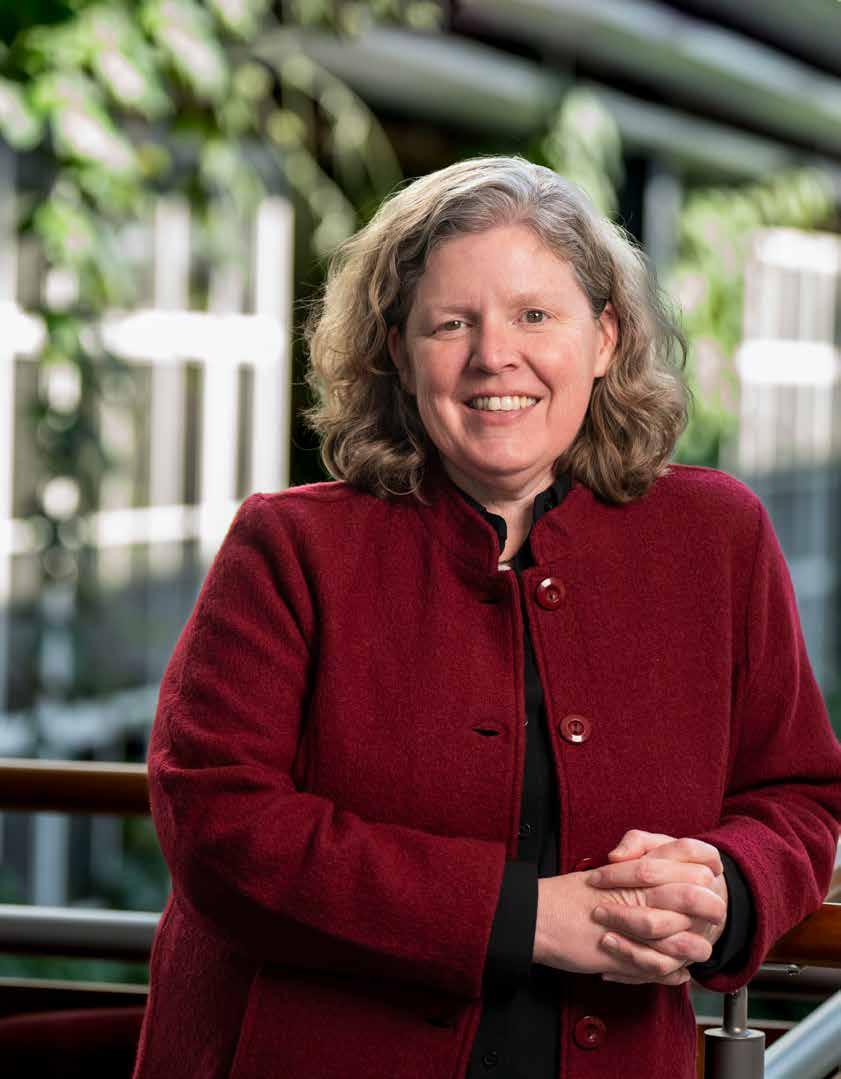
Dr. Diane Bruce
NEW RUBEL SCHOOL DEAN
20 BELLARMINE MAGAZINE
QUESTION & ANSWER
By Carla Carlton and Brendan J. Sullivan
DR. DIANE BRUCE’S appointment as dean of Bellarmine’s W. Fielding Rubel School of Business in May 2023 was a homecoming. Bruce returned to her hometown of Louisville from Naperville, Ill., where she had been the inaugural dean of the School of Business and Entrepreneurship at North Central College and had held a variety of positions since 1997.
Her first job was working as a cashier and a bike mechanic at her parents’ retail store in Shively and later in Fern Creek, where she said she learned about having a strong work ethic, how to do basic bookkeeping, how to work with the public and how to fix a flat tire—“all very important skills.”
At Bellarmine, she is initially focusing on getting to know the faculty, staff and curriculum and “positioning the Rubel School prominently in the Louisville business community as a partner and collaborator seeking to provide the skills desired in the local workforce.”
competitors is the education of the whole person. You know, it’s not just learning about business, but also learning how to think critically, how to communicate effectively, how to work in teams. When you think about all the other areas you study, you're not just using one part of your brain, you're developing all of yourself. And that really helps to position you for a lifetime of learning, growing and moving into various positions, as opposed to just getting that first job.
How do you know that Rubel School graduates will meet workforce needs?
What drew you to Bellarmine?
The values and the mission of the institution really appealed. I was at a similar institution before this, and it had the same focus on dignity, access and equity—those values that I think we all hold dear. It was also an opportunity to come home and be a part of something that I already knew was special and where I could make my own contribution to the city.
What are your goals for the Rubel School?
As I look forward, I want to make sure that we provide opportunities for everyone. I see Bellarmine as a place where people have more opportunity to interact with faculty, they have more opportunity to get internships in some sense because of our connections. I really want to build on those kinds of things, really stress the high-quality teaching that we have—we have outstanding faculty—and continue to make Bellarmine’s one of the best business schools in the state.
What is your sense of Bellarmine’s relationship with the larger community, and how will that shape what you do here?
Since my return to Louisville, I've been
“I see Bellarmine as a place where people have more opportunity to interact with faculty; they have more opportunity to get internships because of our connections. I want to build on those kinds of things, stress the high-quality teaching that we have and continue to make Bellarmine’s one of the best business schools in the state.”
incredibly impressed with how connected Bellarmine is to the business community—how many of the leaders of our local institutions, our accounting firms and our banks have connections to Bellarmine. So I've been really trying to work on those relationships with those individuals to provide internships and career opportunities for students and also just to bring them into the classroom where they can be mentors or talk to students about their jobs or their industries.
How does Bellarmine equip its students to be successful?
I think one thing that makes Bellarmine different from some of our
Over the last few months, we’ve gone out and talked to business leaders about what they're looking for in employees, and we have made some changes to focus on those particular areas. Some of it may surprise you in the sense that it's not just curricular. Of course, we're making sure that students are up to date on current technologies, understand how to use materials ethically and that kind of thing. But we’re also focusing on the soft skills. We’re thinking about how we ensure that our students can communicate. Can they solve problems? We’re trying to build those kinds of things into the curriculum at various points because those are the kinds of skills that are going to move students forward and set them apart from other MBA students or students in general. I mean, it's great if you can run all the numbers and do the spreadsheets. But if you can't communicate what those numbers actually mean, then there's nothing there, you know?
To learn more about the Rubel School’s undergraduate and graduate programs visit www.bellarmine.edu/rubelschool-of-business.
SPRING 2024 21
By Harry Rothgerber

22 BELLARMINE MAGAZINE
’69
Amanda Lucas has a way with words and a passion for music Do you know a member of Bellarmine’s faculty or staff who has an interesting off-campus pursuit? Tell us at letters@bellarmine.edu.
Photo by Jeffery Parrish

AMANDA LUCAS, Bellarmine’s Director of Communication for Content Strategy, has only been developing content for BU marketing and communication projects since June 2023. But she has been conversing through music from an early age. “My parents said I could sing the entire Annie soundtrack before I was two,” she said.
In addition to her role at Bellarmine, Lucas is a parttime lecturer at the University of Louisville College of Business and serves as a social media marketing consultant. But her real passion is music.
“I attended a concert by Trace Adkins and Deana Carter at Louisville Motor Speedway in 1997,” she said. “After watching [Carter] perform, I purchased a used guitar from a pawn shop for $50 and taught myself to play.”
Lucas grew up in Okolona, then moved to Mount Washington and attended Bullitt East High School, where she became a feared softball hitter whose name still graces the KHSAA record books. While earning her Communication degree from Lindsey Wilson College, she interned at a local radio station and later started her own DJ business, in addition to umpiring softball. But music remained significant in her life.
“In 2008 I released my solo album Half Empty, comprising mainly songs I wrote in college,” she said. Shortly after, she reconnected with Audrey Cecil, a former softball teammate who was playing in the band Two Cent Penny. They began to sit in at each other’s shows. Soon, they were collaborating.
“Audrey and I grew up listening to ’90s country,” Lucas said. “So I think our musical style has some country/Americana influence, with a mix of singersongwriter, vintage soul and pop vibes.”
The two won a talent-search contest to play the Lilith Fair tour stop in Indianapolis in 2010. Until that show, they had called themselves simply “Amanda Lucas and Audrey Cecil,” but that confused people who were expecting a band name. So, they came up with one: Bridge 19.
“We had played our first show as a duo at Bearno’s by the Bridge on Dec. 7, 2007,” she said. “That’s how our band’s name originated: 12 plus 7 equals 19.”
Lucas and Cecil were interviewed on Bellarmine’s radio station when they first became a duo, and in 2014, Bridge 19 performed the first official concert for BUKnighted, Bellarmine’s LGBTQ+ identity group.
The duo has produced three albums since 2012. Their fourth record, Midtempo Magic, is scheduled for release this fall.
It will be the first under the band’s new name, RELAAY. The name change reflects personal turmoil and growth that she and Cecil have experienced since the pandemic, Lucas said.
“We have reached a place where we are ready to take
our music to a brand-new place,” the duo wrote on their website in explaining the name change. “We feel lighter, brighter and truer in this new musical life. RELAAY is a word that is a nod to our nearly lifelong friendship and the joy of creating freely.”

The two have experienced some magical moments on stage. Invited to play at Brandi Carlile’s “Raise the Roof” fundraiser in Seattle, Lucas had to confront her major fear of flying. After eliminating travel alternatives, she purchased a plane ticket, and her doctor prescribed relaxation medication.
“When my dad came to take me to the airport to meet my bandmate, I told him I couldn’t do it,” Lucas recalled. “He said I had to deliver the news to her face and took me to the airport. Once there, I tried the medication. Needless to say, it worked!” After playing one of their original songs, they were invited to join Carlile on stage and perform her song “Closer to You.”
In 2019, Bridge 19 opened for and was the backing band for Joan Osborne in Louisville. At rehearsal, Osborne asked Lucas to sing several verses of Bob Dylan’s “Tangled Up in Blue.”
“I told her I didn’t know it,” Lucas said, “and Joan replied, ‘You will.’ I probably listened to that song 200 times during those two days. We also played [Osborne’s] ‘One of Us’ with her—a song I listened to on my Walkman riding the bus home from school. It was surreal.”
As for other influences, Lucas is officially a “Swiftie”—a huge fan of Taylor Swift. “She’s one of our generation's best storytellers and an incredible businesswoman and marketer,” she said.
“What’s meaningful to me is being on stage performing, looking out into the audience and seeing people listening and singing along,” Lucas said.
“It’s also meaningful to be a part of big moments in someone’s life, such as playing a proposal, wedding or party. The fact that someone wants us and our music to be a part of life's important moments means a lot to me.”
Lucas’ music can be streamed on Spotify, Apple Music, Amazon Music, Google Play, Pandora and all other streaming platforms. Albums can be purchased at the group’s shows.
SPRING 2024 23
SECRET LIFE
BELLARMINE MAGAZINE
BOOK CLUB
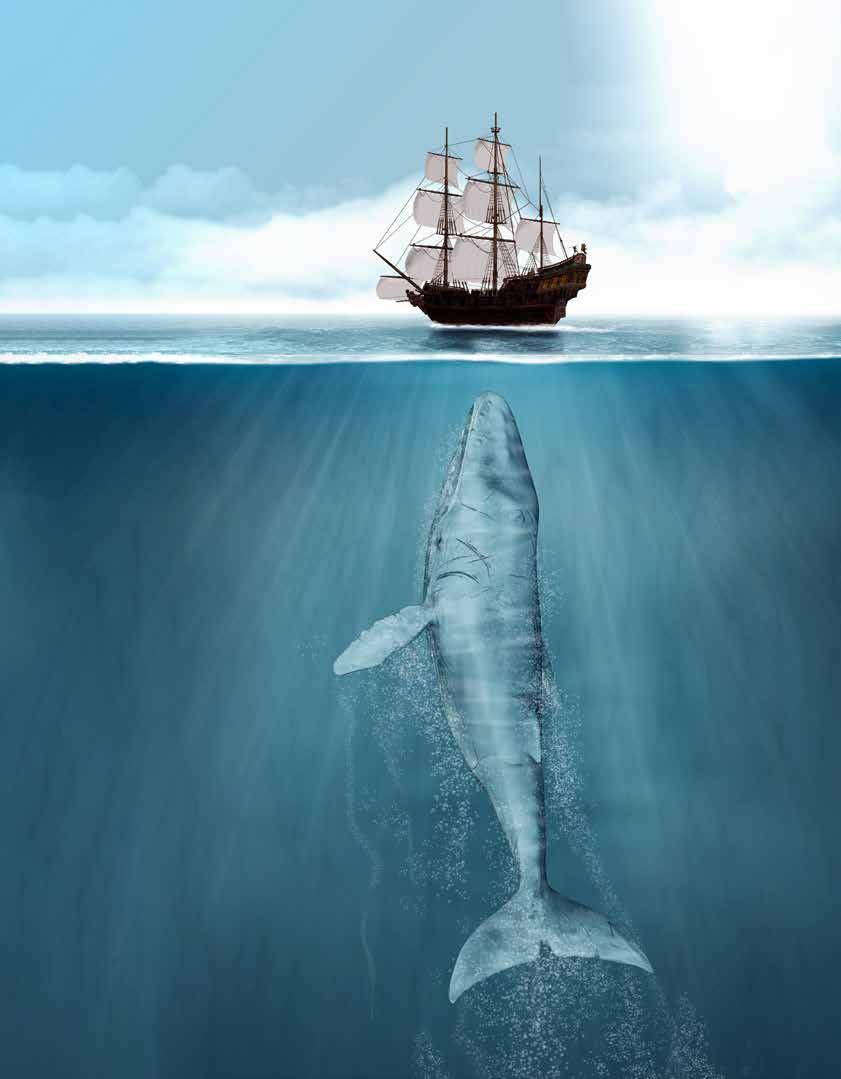
The One That Got Away
Melville’s Moby-Dick is huge and intimidating and was a commercial failure in its time. So why should you read it?
By Jon Blandford, Ph.D.
Herman Melville’s Moby-Dick has long occupied a special place in the popular imagination as the great American novel. When I explain that I study 19th-century American literature, it’s the book people tend to bring up the most, often accompanied by an anecdote about how they were assigned it in high school but maybe didn’t get through the whole thing because wow, it is long and difficult and there’s only so much you can read about sailors tying knots before you find something else to do with your time.
And yet, college-educated Americans, especially of a certain age, seem to think that they should read Moby-Dick, that there’s something distinctive or important about this novel that deserves our attention even now, more than 170 years after it was written. But should they? And should you?
The first thing to know about MobyDick is that it was a notorious commercial and popular failure at the time of its publication. It wasn’t until the early 20th century, when scholars at universities started making a career out of studying American literature, that it was canonized as a novel everyone should read. These scholars, fishing for examples of American literature on par with Shakespeare or Homer, thought they had caught the big one with Melville’s philosophically and aesthetically complex magnum opus. Here was a novel that proved American literature could rival and perhaps even surpass the classics—one that justified including American novels, stories and poems in college courses, writing about them in books and journals, and arguing about them at professional conferences.
Moby-Dick’s privileged status as the quintessentially American novel, however, belies how global it is in scope. Although The Pequod sets sail from Massachusetts with a number of Americans on board— Starbuck hails from Nantucket, Stubb
BOOK CLUB
from Cape Cod, Flask from Martha’s Vineyard—its crew is decidedly international, with representatives from the South Seas (Queequeg), West Africa (Dagoo), Asia (Fedallah) and the Isle of Man (the Manxman).
Ishmael, the novel’s narrator, is named after the Biblical son of Abraham who was exiled from his home to wander in the wilderness; Ahab, the ship’s doomed captain, has, we are told, spent the better part of four decades at sea; and the AfricanAmerican Pip, who is from Connecticut but referred to as the “Alabama boy,” reminds us that America’s economic growth was built on the backs of people kidnapped and brought overseas as part of the transatlantic slave trade and their descendants.
“The ship functions as a microcosm of sorts for a 19thcentury world increasingly interconnected by the global flows of commerce, trade and cultural exchange, a blurring of national boundaries that has only accelerated in the decades since.”
The conspicuous absence of women notwithstanding, the ship functions as a microcosm of sorts for a 19th-century world increasingly interconnected by the global flows of commerce, trade and cultural exchange, a blurring of national boundaries that has only accelerated in the decades since.
The fact that this supposedly most American of 19th-century American novels is, upon closer inspection, cosmopolitan in ways that anticipate the 20th and 21st centuries is indicative of how it constantly challenges us to reorient and reexamine our perspective. Ahab’s view of Moby-Dick is, it turns out, tragi-
cally limited. As we often do with nature, he anthropomorphizes the white whale, seeing it as a version of himself, a creature that took his leg on purpose, that plots and seeks to acquire as he does. And, as we also often do with nature, he sees the whale as something to be dominated, conquered, mastered, overcome. These ways of seeing are not only deeply flawed but also (spoiler alert!) eventually lead to Ahab’s own destruction.
Ishmael, by contrast, employs a kaleidoscopic, constantly shifting set of perspectives. He interrupts the main narrative with seemingly digressive chapters on the science of whales, on the whale in art, mythology and religion, and on the whale as commodity. It may be tempting to skip over these chapters to get to the action, but I would argue that they are where the action ultimately lies. Each of these chapters represents a lens through which Ishmael attempts to see, understand and represent the whale; each shows him something new, but each alone is inadequate to capture the whale in its inscrutable and essential whaleness, in its mystery, majesty and wonder. Moby-Dick, both the whale and the novel named after the whale, exists both within and outside all these interpretive schema, approachable through an impossibly wide range of discourses but irreducible to any single one.
In that regard, Moby-Dick is not just a great work of literature. It is a novel about what makes great literature great. It is a novel that, like the whale at its center, invites us to look and look again, to revisit and revise our assumptions and interpretations while remaining always alive to new possibilities and discoveries. So yes, you should read Moby-Dick. And if you have read it already, you should read it again. Its depths may be unplumbable, but they are well worth diving into.
Dr. Jon Blandford ’00, an associate professor of English, is Bellarmine’s assistant provost. He has been a member of the English Department faculty since 2011, serving for seven of those years as Bellarmine’s Honors Program director. Dr. Blandford has published research in both his home discipline of 19th-century American literature and in Honors and recently served threeyear terms as both the president of Kentucky Honors Roundtable and secretary of the Southern Regional Honors Council.
SPRING 2024 25

Learn more: bellarmine.edu/conferences-and-events/TEDx
Photo by Brendan J. Sullivan
Event photos by Hailey Woodward and Emily Carpenter
TEDxBELLARMINEU
A great idea that just keeps growing
By Carla Carlton
AT 4:30 P.M. ON THURSDAY, MARCH 14 , Angela Miller perched on the edge of the stage in Cralle Theatre. Bellarmine’s sixth annual TEDxBellarmineU event was a little more than 24 hours away, and Miller, an adjunct faculty member in the Communication Department, was running through the schedule for that night’s full-dress rehearsal with the core TEDxBellarmineU team.
She handed out two-way radios to those who would need them. For the next hour students would position and check microphones and make sure their video equipment was working. They would set up tables, chairs and scenery in the lobby and the Black Box Theatre, where pre-show entertainment would be held. Patrick Jump, a theater technical director, would check the lights in both theaters. At 6:15 p.m., the first of the seven speakers would take the stage for the run-through.
“There’s going to be a lot of moving parts here tonight,” Miller said. “Please be safe, be careful and help each other.”
TEDx is a program of local, self-organized storytelling events that are licensed by TED, an international nonprofit organization devoted to “Ideas Worth Spreading” that was founded 30 years ago. They consist of a series of short (no longer than 18 minutes), carefully prepared talks, demonstrations and performances on a wide range of subjects.
Putting on a TEDx event “can be an extraordinary experience,” the TED website says. “It’s also a big commitment.”
It’s such a commitment, in fact, that only 40 percent of all organizations that hold licenses from TED ever produce a second event, said Dr. Shawn Apostel, associate professor of Communication and Bellarmine’s license holder. Just qualifying for a license is a major accomplishment.
But Bellarmine has produced a TEDx event annually since 2019—including one during the pandemic.

What makes Bellarmine’s TEDx program so successful?
“It’s the students,” Apostel said. “They are hard workers, they’re creative and they do amazing work.”
“The license holders that do one or two events are usually trying to do it all themselves,
and you just can't. You have to delegate, and I trust my students to do a good job. I'll give feedback and I might push them a bit to do it a little bit differently, but in the end it's theirs.”
The students on the TEDxBellarmineU Core Team help select each year’s theme—this year’s was “Community Resilience”—choose the speakers and handle administrative duties including budgeting, marketing and catering. While the program is a natural draw for students in Communication, the team also includes students from majors as varied as Business Administration, Music and Health Sciences.
Working on TEDx is voluntary and provides no academic credit, but the experience is more valuable than credit, said Abigail Bullock, who will graduate with a Communication and Design, Arts & Technology (DAT) double major in May 2024 and spent all four years working with TEDxBellarmineU. She is an assistant stage manager and co-emcee and also handles administrative tasks such as scheduling meetings and booking rooms.
“It's so much more than just putting on a theater production, and it doesn’t feel like a school project,” she said. “It’s an opportunity to integrate what I've been learning in college into a more real-world setting. It's also a wonderful networking opportunity. You get to know so many students from different areas, and we all come together for this one thing.”
And like all things TED, it began with an idea.
Let’s do a show
Joining Bullock and other current students in Cralle Theatre on March 14 was Jacob Schuhmann, who graduated from Bellarmine in 2017 with a major in Communication and is now director of business development for a national company.
Schuhmann has served as an emcee for TEDxBellarmineU four times, including the inaugural event in 2019.
“It’s his fault you are all here,” Miller joked to the TEDxBellarmineU core team.
Schuhmann was an underclassman when he saw the words “TEDx at Bellarmine” written on a whiteboard in Apostel’s office. Another student, Quincy Nelson, had initially suggested to Apostel that Bellarmine pursue a TEDx event, but Nelson didn’t get past the research phase before graduating.
“Quincy made a lot of progress, but we weren't there yet,”
SPRING 2024 27
Dr. Shawn Apostel
Apostel said. “Jacob walked in and said, ‘Quincy’s not here anymore, right? Can I do that?’ And I'm just curious enough to try anything, so we kept going at it.”
“It made a lot of sense to me that a university like ours could put something together that brought in new ideas,” Schuhmann said. “When I was in undergrad, we had some controversial figures come and speak. And I thought, We need to be this place.
“We had no idea how complicated was going to be.”
Getting a license from TED took two years, Apostel said. The first time he applied under Schuhmann’s name, not realizing the license holder had to be the primary organizer. “Then I applied again, and apparently didn’t say things the way they wanted me to say things.” (To say that TED zealously protects its integrity is an understatement.)
The third time, Apostel was successful. TEDx licenses are valid for one year, for one event, in the city where the license is held, so he must reapply each year. Initial licenses restrict attendance to 100 people, so the first TEDxBellarmineU event, in 2019, was held in the Black Box Theatre.
“That first year we were begging for speakers,” Apostel said. “We weren't established yet, but it was ridiculous how many people we got. It was like 16—a lot of people. And we learned really quickly to limit it to seven or eight. It's just too much with more than that. It was wild.”
Schuhmann graduated before that first TEDxBellarmineU event, but he returned to serve as emcee, a role he has held every year except the pandemic years of 2020 and 2021. He’s on the road for work about 75 percent of the year, but he always makes time for TEDx. “It keeps me connected to a really, really cool time in my life,” he said. “And it's a lot of fun.”
He downplays his role in getting TEDxBellarmineU off the


ground. “It's always been about the team. I don't know if I really did anything independently. I just brought in the right people that could do it because I was involved in a lot of organizations. And what's so cool is that that’s just like what my job is now: I build projects with teams across the country.”
This year TEDxBellarmineU received 192 applications for its seven speaking slots. “That’s a 3 percent acceptance rate,” Apostel said. “So it’s pretty competitive, and it’s getting more so.” And applicants are no longer just from the Bellarmine community. “We’ve even had people come from Canada,” Miller said.
According to TED rules, speakers can neither pay nor charge speakers—but they do receive a gift bag and media exposure: Each speaker is videotaped, and the videos are posted on the TEDxBellarmineU YouTube channel and sent to TED, which may also share them on the TEDx channel. “We now have millions of views of our videos because TED publishes them,” Apostel said.
A sign of singularity
One thing that makes TEDxBellarmineU stand out is its sign. TED rules dictate the outline of the TEDx logo, which must be red. “You can’t change the outside of it, but you can change the inside,” said Dr. Shawn Apostel, Bellarmine’s license holder.
So every year, TEDxBellarmineU commissions an art student to create the design inside the letters, which were fabricated by Dr. Laura Hartford, associate dean of the Bellarmine College of Arts and Sciences, and her brother-in-law Steve Baker.
This year’s sign was created by Ari Eastman, a first-year major in Digital Design and Digital Art from Louisville who operates a graphic design business called Super Weird Studios. His design, he said, is a visual homage to “Community Resilience,” this year’s theme.
Through digital illustration, photography and collage, it depicts the Big Four Bridge; Bellarmine’s bell tower, entrance arch, Centro and Our Lady of the Woods Chapel; horse imagery; and finally, in the “x,” the Bellarmine Knight.
“The sign celebrates the spirit of resilience within the Bellarmine University and Louisville communities, emphasizing commitment, interconnectedness, community engagement, diversity and inclusivity as steady beacons in a changing world,” Eastman said.
28 BELLARMINE MAGAZINE
L-R: Evan Bullock, Abby Bullock, Will Long
The videos and still photos at each event are made by student photographers and video editors. “They are spot on, and I don't have to hire that out,” Apostel said. “I was talking with one university, and they budgeted $60,000 for their event. Oh my God. We do ours for like $5,000—and that includes food. And it's because we have Bellarmine students.”
After attending a qualifying TED conference, Apostel can now apply for a 300+ TEDx license. “I could book the YUM! Center now—there’s no limit on the audience,” he said. “But I like having people from the community here on Bellarmine’s campus. I think that's important.”
Cralle Theatre holds about 320 people, and this year’s show was at capacity. The Black Box now serves as a space for preshow entertainment, including live music and games.
“The core of it was just to have a place to spread new ideas,” Schuhmann said. “And it's blossomed into something you would have never imagined.”
Getting organized
Back at the dress rehearsal, senior Gisela Martinez, who is in her second year with TEDxBellarmineU, has a question for Miller: “Should we have the big potted plants hidden in the Black Box, or not?”
“I will have no opinion,” Miller replies. “That’s RSO life for you.”
This year, TEDxBellarmineU became a Registered Student Organization (RSO) with the goal of making the program self-sustaining. The move allows TEDxBellarmineU to apply for funding from the Student Government Association and to retain any profit from the annual events. Before this year, any money left at the end of the fiscal year went into Bellarmine’s general fund. Tickets this year were $30, with a limited number of early bird tickets for faculty and staff available for $25.
Bullock is the RSO president, and Martinez, a student from Merida, Mexico, with a double major in Economics and Business Administration and a minor in International

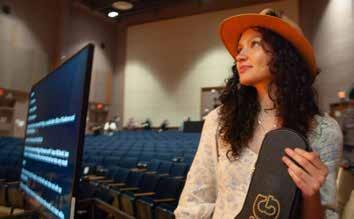
Studies, handles the group’s finances. She got involved with TEDxBellarmineU in her sophomore year when Miller recruited her from her public speaking class.
“TEDxBellarmineU has helped me develop communication, organization and time-management skills,” she said. “I was able to apply the finance knowledge I have acquired in my classes by being the team’s treasurer. I have also built a strong resume; the event planning expertise I developed through TEDx helped me get my current internship with the American Heart Association as the Development and Community Events intern.”
TEDxBellarmineU is definitely a great thing to have on a resume, Miller said. “Everyone has heard of TED.”
Martinez will also graduate in May 2024. But another thing that makes TEDxBellarmineU self-sustaining is that each core member is responsible for training a “mini-me”—an underclassman who will be able to step into their role. “I am constantly asking them, ‘Who is your mini-me?” Miller said. “ ‘Who are you mentoring to make sure you have a legacy’?”
Alumni of the program also have a tendency to return, she said.
Jacob Gagel ’21/’22 MAC, Bellarmine’s assistant director of Alumni Engagement, was a camera operator for TEDxBellarmineU as a student. “Now I am more of an overseer and help out where needed, mentoring those who are interested in the video production side of things. One of the things I love doing is making films, so being able to help and pursue that passion is always a fun thing to be a part of.”
Bullock predicts she will do the same. “I'm going to be here for grad school next year getting my master’s in digital media, but don't worry—I’ll still be here.”
Gagel said he’s proud that Bellarmine is becoming known in the area for TEDxBellarmineU. “TEDx is about seeking new ideas, being inclusive, and sparking deeper discussions and connection,” he said. “That’s essentially what Bellarmine is about.”
SPRING 2024 29
Lucas Rogers ’20 returns each year to help.
Bellarmine student Zoey Parker, a 2024 presenter
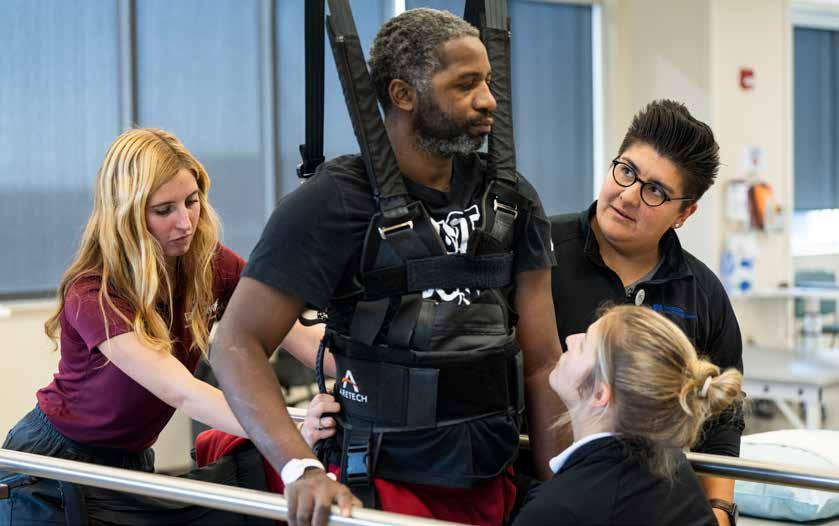
‘A STRONGER AND HEALTHIER COMMUNITY’
Physical Therapy, Norton Healthcare partner on nation's first accredited neurologic fellowship
Story by Carla Carlton Photos by Brendan J. Sullivan
IN A BRIGHT, spacious room in the Norton Neuroscience Institute in east Louisville, Ray Trowell stands trembling between two handrails. Supported by a ceiling-mounted harness and two Bellarmine students, he takes a shuffling step forward.
Before Trowell, a stroke patient, started coming to Bellarmine’s Service-Learning Clinic at Norton Healthcare’s Cressman Neurological Rehabilitation Center two years ago, he couldn’t get out of bed or sit in a chair. He had quickly burned through the 20 rehab visits his insurance plan allowed and couldn’t afford more.
At Cressman, one of Bellarmine’s seven service-learning clinics, the care is provided pro bono. First- and second-year Doctor of Physical Therapy (DPT) students work with patients like Trowell who have a range of neurological movement disorders twice weekly for six-week rotations.
Trowell views his visits as “a fair exchange.” He receives care that improves his quality of life, and the students get hands-on experience that will make them better physical therapists—and may help them decide on their area of specialty.
“I thought I was going to do sports medicine. But when I shadowed at a sports clinic, I didn’t enjoy it as much as I thought
30 BELLARMINE MAGAZINE
I would,” said Kross Locke, a second-year DPT student. “It was like, ‘Here is the fifth straight ACL patient.’ This is the most rewarding place to work. Stroke patients are so unpredictable; you have to come up with a new plan every day.”
The DPT Service-Learning Clinic is just one facet of a longstanding partnership between Bellarmine’s Physical Therapy program and the Norton Neuroscience Institute.
Most recently, Bellarmine and Norton Healthcare launched the nation’s first fellowship in neurologic physical therapy.
The Neurologic Movement Disorders Physical Therapy Fellowship, which started in November 2023, is a collaboration between Norton Healthcare and The Ohio State University Wexner Medical Center in Columbus, with support from Bellarmine’s School of Movement and Rehabilitation Sciences and The Ohio State University School of Health and Rehabilitation Sciences.
“The neurologic PT fellowship supports Bellarmine’s continued strategic focus on entering mutually advantageous community partnerships,” said Bellarmine President Susan M. Donovan. “When we work with a partner, our students learn more, our partners gain expertise and our community gains highly trained professionals. As a result, our neighbors and our region enjoy a better quality of life. The ultimate outcome of these partnerships is a stronger and healthier community.”
The 12-month fellowship is available to candidates who work at Norton Healthcare and/or the Wexner Medical Center. Participants are employed full-time with benefits and pay no tuition.
The goal is to develop physical therapy specialists who can address the rehabilitation needs of patients with movement disorders, including Parkinson’s disease, essential tremor, ataxia and Huntington’s disease.
“We are so excited to offer this opportunity to allow clinicians to feel more confident in the evaluation and treatment of these complex neurological disorders,” said Dr. Elizabeth Ulanowski, an associate professor in the Bellarmine DPT program who is directing the new fellowship.
“The fellowship is something I have been working toward for our community for over five years. These patients need our support and innovation. Exercise and movement are a big part of their overall care, and through evidence-based interventions our goal is to support clinicians, patients and families so we can make this journey easier.”
The fellowship builds upon the yearlong Bellarmine-Norton Healthcare Neurological Physical Therapy Residency, which is in its 12th year. Neurological residents work with patients across Norton Healthcare’s acute care and outpatient settings and at Cardinal Hill Rehabilitation Hospital in Lexington, Ky. They also conduct entry-level neurological lectures and labs at Bellarmine. The residency has been a catalyst for increasing the number of board-certified neurologic clinical specialists in the

Dr. Amber Faraji
region, according to Ulanowski, who also directs this program.
Dr. Amber Faraji, a neurologic certified specialist who graduated from Bellarmine’s DPT program in 2019 and completed the Bellarmine-Norton Healthcare Neurological Physical Therapy Residency, is the first neurologic movement disorders fellow at Norton Healthcare.
She serves as an adjunct faculty member at Bellarmine and mentors students at the service-learning clinic, where she discovered her career path as a student.
“That is when I really started wanting to work with individuals with neurological disorders—specifically movement disorders,” Faraji said. “I thought I was going to be an orthopedic physical therapist. Taking neurology courses and getting to work with an individual through the clinic just totally changed what I wanted to do after graduation.”
Faraji is one of a number of Norton Healthcare physical therapists who serve as adjunct faculty in Bellarmine’s DPT program. Norton Healthcare makes this possible by incorporating the teaching time into their clinic schedules.
“We feel that it’s a benefit not only to keep our therapists engaged, but also to bring the most current physical therapy education back to our clients,” said Melanie Hoehn, director of rehabilitation services at Norton Brownsboro Hospital.
Jeanette “J.” Lanoire ’17 DPT, a neurologic clinical specialist at Cressman Neurological Rehabilitation, is another adjunct faculty member at Bellarmine. She completed the BellarmineNorton Neurological Physical Therapy Residency in 2018 and now serves as a mentor in the Bellarmine Service-Learning Clinic.
The clinic experience “makes Bellarmine students shine,” she said. “Patient interactions and patient connections are honestly sometimes half the battle—being able to connect with who you’re working with and getting them to do things that they may not always want to do. The Service-Learning Clinic provides students that one-on-one, real-life patient experience.”
SPRING 2024 31
AUSTIN ADAM’S
A National Parks odyssey, from Alaska to American Samoa
By Carla Carlton
Photos by Austin Adam

MOST PEOPLE COME HOME from a vacation with lasting memories and beautiful photos. Environmental consultant Austin Adam ’17 came home from a 2017 road trip with a mission: to visit every one of the 63 U.S. National Parks.
A trip to Virgin Islands National Park in December 2023 completed the mission.
“After doing a summer field job with Colorado Parks & Wildlife in 2017, I had the opportunity to do a three-week road trip hitting every national park in Utah, Arizona, New Mexico and Texas,” he said. “While I had been to a few national parks before then, that is really when I realized how much I enjoyed it and thought it would be a rewarding goal to have.”
Congress designates National Parks as protected areas operated by the National Park Service, an agency of the Department of the Interior. Adam’s first national park was Badlands, in South Dakota, in 2010. He completed the bulk of the trips in the past six years.
The Floyds Knobs, Indiana, native, who graduated with a major in Environmental Science with a minor in Biology in 2017, is now an environmental consultant for an engineering and environmental firm in Oakland, California.
“As someone who works within the environmental field and has a love for the outdoors, it is amazing to visit, see and experience everything our national parks offer,” he said. “You have some of the most pristine environments on the planet, the most unique geological processes, a rich history from the indigenous tribes who this land belongs to. Every ecosystem and animal you would want to see can be found in a national park.”
Austin’s Top 3
Wrangell-St. Elias National Park, Alaska
This park is extremely remote and offers things I only experienced here. At this park, I iceclimbed on glaciers, went underneath glaciers into ice caves, and explored a historical copper mine. I also took the best flightseeing tour I’ve ever taken, flying about multiple mountain ranges, glaciers, ice sheets and glaciers calving into the ocean.
Isle Royale National Park, Michigan
This island in Lake Superior is remote; you must take a six-hour boat ride or a one-hour seaplane ride to get to it. I found the mix of the mountainous spine of the island along with the rocky coast to be stunning for backpacking.
Olympic National Park, Washington
This park offers so much to see: rainforest, rocky coastlines and glacier-carved mountains. I've visited three times and have had different views and experiences each time. I’ve also seen a large amount of wildlife.
32 BELLARMINE MAGAZINE
ADVENTURE
BIG


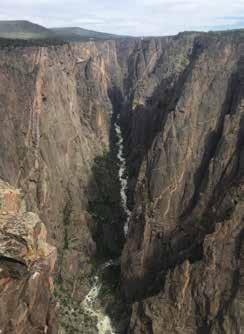





SPRING 2024 33
Wrangell-St. Elias in Alaska is the largest National Park.
Olympic National Park in Washington St.
Black Canyon of the Gunnison National Park in Colorado
Wrangell-St. Elias in Alaska is the largest National Park
National Park of American Samoa is the southernmost national park
Lake Clark National Park in Alaska
Voyageurs National Park in Minnesota
National Park of American Samoa is the southernmost national park


34 BELLARMINE MAGAZINE
Katmai National Park in Alaska
Hawaii Volcanos National Park on the Big Island

 Kenai Fjords National Park in Alaska
Great Smoky Mountains National Park in North Carolina/Tennessee
Kenai Fjords National Park in Alaska
Great Smoky Mountains National Park in North Carolina/Tennessee
ACADEMIC SPOTLIGHT: PRE-LAW
Need the thinking, writing and speaking skills to practice law? Three grads, a faculty member and a student testify for Bellarmine’s program
By Aili Whalen

What are you doing now?
Kelzé Riley: I will be finishing law school this year and starting legal practice as a labor and employment attorney in a law firm after that.
John Selent: I am a partner at the law firm of Dinsmore & Shohl and have been for 27 years. I have practiced public utility and banking regulatory law since I graduated from Notre Dame law school 44 years ago.
Christine Ward: I have been a judge since 2015. I’m in the second term of an elected position. There are 10 Family Court Judges serving Jefferson County. One judge presides over all the legal matters affecting the same family. A Family Court Judge may preside over litigation seeking a domestic violence protective order; a divorce and/or child custody and support; establishment of paternity and child support; adoption; and termination of parental rights. We also handle matters of child dependency, neglect or abuse and family recovery court for parents affected by substance-use disorders.
Craig Dilger: I am a trial lawyer at a law firm where I am an
equity member and receive a share of the firm’s profits. My practice now is in health care, athletics and “bet-the-company” litigation. Before this, I spent eight years in law enforcement as a prosecutor.
How did Bellarmine prepare you for law school and legal practice?
Kelzé Riley: I would not be where I am today without the support of Bellarmine’s faculty and staff. I’m now at a public university, and there is way more love and care for students at Bellarmine. I was a first-generation college student who came to Bellarmine after Bishop Hartley High School in Columbus, Ohio. Bellarmine prepared me well for law school, particularly the small class sizes and my interactions with teachers. Dr. Lee Remington, one of my political science professors who has a JD as well as a Ph.D., was very intentional in helping me. She talked to me outside of class and pointed me in the right direction when I was applying to law schools. She was also a role model for me, since, like me, she is passionate about civil rights. When she was in law school at the University of Louisville, Dr. Remington got the Alberta Jones case reopened. Alberta Jones was one of the first black women in Kentucky to pass the bar exam, in 1959. She was active in civil rights, and in 1965 she was murdered, her body found in the Ohio River. I am one of the students who received the Alberta O. Jones Scholarship (in 2021), and it helped to jump-start my law school career.
John Selent: Bellarmine taught me to think and write clearly. The faculty insisted that we express ourselves clearly in writing, as clear writing reflects clear thinking. In the legal profession, both are imperative. Moreover, a liberal arts education at Bellarmine is life accelerated. A Bellarmine education exposes you, albeit mostly vicariously, to practically every situation you will encounter in life, and how the great minds of previous generations responded. These include both the personal, such as addressing your own mortality and that of others, and the professional. For example, from a professional perspective, my Bellarmine economics professors
36 BELLARMINE MAGAZINE
would say that the regulation of monopolists is required to impose the rigors of competition to the benefit of both the monopolists and the customers that they serve.
Christine Ward: I became a lawyer because I got involved in the Bellarmine Mock Trial program. The team was so much fun. Jim and Ruth Wagoner, who ran Mock Trial at the time, invested so much in their students. I wouldn’t have considered law as a profession but for them; I have no lawyers in the family and am a first-generation college graduate. Dr. Gail Henson was also a significant influence on my life. Like so many of my professors, she gave me the tools I needed to be confident in my abilities. At Bellarmine, the professors personally invest in you. The school is designed to make you think for yourself, for the world, and to make a difference. It’s a holistic approach to education.
THE PANEL


“I think the most important parts of our Pre-Law Program, true to the mission of Bellarmine, are the one-on-one advising and ongoing relationships our students develop with pre-law faculty who are law school graduates themselves and our extensive network of lawyer alumni.”
– David C. Scott
Craig Dilger: Bellarmine helped me to find the path I needed to be on. I don’t think that happens at other schools. Law’s been great for me. The years when I wanted to be in trial every other month, I was. I didn’t always want to be a trial lawyer. There were no lawyers in my family, and my parents owned businesses. I started off at Bellarmine as a soccer player. Then an injury forced me to quit. I wasn’t sure that I was going to stay at Bellarmine, but I was taking a Communication class with Ruth Wagoner. After hearing me during a public speaking component, she asked me to stay after class. She then talked me into Mock Trial. I loved it and started competing for that team. It’s incredibly important to have that broad spectrum and foundation of things you should know about that Bellarmine’s liberal arts education provides. How are you going to be a person who resides in our world when you only know one thing?
What advice would you give someone considering law school?
Kelzé Riley: It’s tough to show up every day. What keeps me going is that people believe in me. Relying on others is the best way.
John Selent: I would suggest evaluating your strengths and weaknesses. At Bellarmine, play to your strengths and address your weaknesses. Admission to law school will require a strong academic record, and so this is imperative. I would also suggest
JOHN E. SELENT ’77, History major. JD, Notre Dame Law School. Partner, Dinsmore & Shohl LLP.
CRAIG C. DILGER ’91, Business and Economics major. JD, Northern Kentucky University College of Law. Member, Stoll Keenon Ogden PLLC.


JUDGE CHRISTINE WARD ’91, English major. JD, University of Kentucky College of Law. Chief Judge of Family Court, Jefferson County Circuit Court.
KELZÉ RILEY ’21, Political Science major. 2024 JD candidate, University of Cincinnati College of Law. Student Bar Association president; Student Legal Education Committee representative; editorin-chief, Immigration and Human Rights Law Review. Incoming Labor and Employment associate at Keating Muething & Klekamp PLL.


DAVID C. SCOTT, JD, PH.D., assistant professor of Philosophy and director of Bellarmine’s Pre-Law program. JD, Harvard Law School; Ph.D. in Philosophy, University of Kentucky.
NORAH WULKOPF ’25, Political Science and Communication major, Philosophy and Refugee and Forced Migration Studies minors. President of the Bellarmine Mock Trial team.
For information on Bellarmine’s Pre-Law program, contact David Scott at dscott3@bellarmine.edu
SPRING 2024 37
that you learn as much as possible about everything. In my experience in corporate law practice, there is little, if anything, that I have learned that has not proved useful in representing the firm’s clients. I would suggest being prepared to work hard and to enjoy life. At Bellarmine, at law school and thereafter, be careful not to miss the forest for the trees. All work and no play makes for a sad life and, I would say, both an unsuccessful life and career. Finally, I would strongly suggest it is imperative to take an LSAT preparation course either at Bellarmine or otherwise to increase prospects for admission to law school and financial aid.
Christine Ward: I would suggest taking courses that teach you to write. Being a double major in both English and Communication honed my writing skills and developed my confidence. Lawyers must be able to make clear written arguments, and judges must be able to write clear, concise orders.
Craig Dilger: Law is not just for people who do well in traditional classrooms. Something a lot of people don’t know about me is that I have fairly significant learning disabilities. I was the first person in the state of Kentucky to get extra time on law exams and the very first person in Kentucky to take the bar exam under the Americans with Disabilities Act. I passed it the first time. It helps if you have an assertive personality because to be a lawyer you have to stand your ground. You need to know the idea you have is a good one and has promise before you can communicate that to others. Mock Trial can help with this.
David Scott: First, I think it’s helpful to talk to as many law school graduates as you can in deciding on your path. There are so many more options out there than the traditional courtroom setting. As someone who didn’t grow up around any lawyers, direct contact with attorneys was the only way I was able to figure any of that out. Second, you should make sure that you take courses that both challenge you and hone the skills that will be at the core of your law school experience, such as reading and analyzing difficult texts, developing creative solutions to difficult political, legal, and moral problems, and being able to thoroughly explain your position orally and in writing. There are many courses that help you with one or more of these, so consulting with your prelaw advisors in crafting your course plan is advisable. Third, if you do decide law school is probably for you, I would begin developing a plan for studying for the LSAT before the beginning of your junior year. Though there are many components of your law school applications, developing and sticking to an LSAT study plan requires the most planning and has the greatest potential benefit for your law school admissions results. Treat the LSAT like one of your most important classes: A higher score can open doors and secure scholarships like almost nothing else in your prelaw preparation can.
What is Pre-Law at Bellarmine like today?
David Scott: I think the most important parts of our Pre-Law Program, true to the mission of Bellarmine, are the one-on-one
advising and ongoing relationships our students develop with pre-law faculty who are law school graduates themselves and our extensive network of lawyer alumni. I typically try to bring a diverse set of Bellarmine alumni and law school representatives to campus as often as I can so that students can feel more confident that competitive law schools and exciting careers are not a world apart, but very much attainable to them. Very often our prelaw students also join the Prelaw Society, a student-run organization that organizes some great events and helps prelaw students across majors develop a strong sense of community with one another. Our prelaw internship program allows students to receive 3 hours credit for 90 contact hours with local or regional employers in an area of law that interests them. And recently we started an in-house LSAT course that I teach that is funded in part by Bellarmine donors so that we can offer it at a fraction of the cost of private LSAT courses.
Norah Wulkopf: I’m the president of the Mock Trial team, which is hard work but a lot of fun. There’s no better feeling in a trial than sitting at counsel table and watching your best friend grilling a witness on cross examination when the witness says something they’re not allowed to say. Your friend comes back to impeach them and you’ve already got the affidavit pulled up and are showing them the exact line they need to finish the job. The University of Louisville has no mock trial team for undergrads. We also have an amazing coach, Shamir Patel, who has 15 years of experience with Mock Trial. At the University of Kentucky they are entirely student-run. I take a lot of Pre-Law classes because I want to do immigration or special victims prosecution someday. I take a polisci class on international legal issues, for example, and an Honors interdisciplinary course called the Law of the Land about legal issues that arise in conflicts over land. I also have an internship with the Jefferson County Attorney’s Office, where I help out the Special Victims Unit by interviewing victims of misdemeanor and felony domestic violence.
Are there majors that are better than others for law school?
David Scott: In theory, you can major in anything and go to law school. These majors include Criminal Justice, Political Science, Philosophy, English, History and Economics. The Pre-Law Program also has a list of relevant courses. We have law schooleducated faculty teaching across disciplines. The sets of skills taught in the courses above assist in excellence in law school, in part because there won’t be time once you get there to work on those skills. These include the ability to analyze arguments of others and make rigorous arguments of your own, reading comprehension, some understanding of law-making processes and related institutions, time-management skills, and the ability to think about societal complex problems and develop creative solutions.
38 BELLARMINE MAGAZINE



SPRING 2024 39
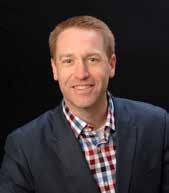
Q&A with Matt Real, new Executive Director of Alumni and Constituent Relations
In January, Matt Real moved across the street from Bellarmine’s Career Development Center, which he had led for eight years, to Allen Hall, where he is the new Executive Director of Alumni and Constituent Relations. Before coming to Bellarmine, he worked in employer relations and career development at the University of Louisville.
In his new role, Real is responsible for developing and implementing strategic initiatives to engage, support and enhance Bellarmine’s connection to alumni. The job requires a combination of leadership, communication, event-planning, fundraising and relationship-building skills, he said, “amplified by a deep passion for our shared mission and values and an understanding of the unique academic and experiential learning that happens on campus and in the community.”
In his spare time, Real is often on the hunt for older, rare soul and rock & roll 45 rpm records to add to his large vinyl collection.
Congratulations on your new position! What are you most looking forward to?
Thank you. I am honored and excited for the opportunity to lead the Alumni Association. I would describe myself as a strategic connector, story collector and Bellarmine believer, so what I am most looking forward to is the opportunity to meet, learn, understand and celebrate the distinctive experiences and special relationships alumni have with the university. Of course, I am also excited about creating memories at Trivia Knight, Alumni Weekend and Brew at BU, and the many exciting athletic events throughout the year. What a fun job!
How
will your experience in
inform your new role?
Career Development
Collectively, I have over 16 years of working in Career Services,
and my experiences counseling, advising and guiding students through self-discovery, decision-making and career readiness will continue to inform my support of our over 27,000 alumni who are currently in the workforce. In addition, throughout my tenure in Career Development at Bellarmine, I have been able to build meaningful and lasting relationships with not only those eight graduating classes of young alumni (and many, many additional alumni), but also with employers, faculty, staff and community partners. Hearing students’ and employers’ needs and interests has provided me with a deep understanding of relationship dynamics, how to connect people to opportunity, design strategic experiential learning initiatives, guide conversation around purpose, develop personal narratives with intention, and focus energy on strengths and possibility. I’m confident that I can help support alumni by extending those relationships and designing distinctive programming that will provide them with a sense of meaningful connection to Bellarmine.
How can our alumni help you succeed?
Every alum I meet has such an interesting and personal story of what Bellarmine means to them, and I love hearing those stories. Success for Bellarmine in the future will be determined by how sustained our alumni support each other, current students and the university. So, alumni can help simply by finding their way to support Bellarmine. Attend a campus event, volunteer for a leadership position, bring a classmate to Alumni Reunion Weekend, register a team for Trivia Knight, cheer on our student-athletes, hire an intern, become a mentor, provide for student basic needs (food, clothes, transportation), give when and how you can, share your ideas, and wear Bellarmine with pride knowing you are part of an exclusive, caring and talented family of alumni. I hope you will reach out to connect at alumni@bellarmine.edu.
40 BELLARMINE MAGAZINE THE ALUMNI CORNER
Future Knights of Bellarmine
Knights arrive every day! One day soon, these children of proud Bellarmine grads may also don the Scarlet and Silver. Send us a photo of your Future Knight! Fill out a class note at alumni.bellarmine.edu/BUclassnotes.





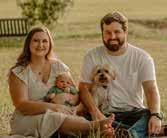




1. Jessica Berry Wimsatt ’00 welcomed son Lucas Michael to her family June 25, 2023.
2. Austin Bailey ’15 and his wife, Lauren, welcomed their first child, Beckett, in May 2023.
3. Bevan Sparta Spencer ’14 and Graham Spencer ’13 welcomed their second child, Poppy Irene Spencer, on Nov. 2, 2023.
4. Dusty Nuss ’20 and her fiancé, Richard Becker, welcomed Sylas Becker on May 29, 2023.
5. Katy McWhorter ’22 and Jacob welcomed son Thomas on Aug. 12, 2023.
6. Kevin Klein ’18 and wife Josephine welcomed daughter Georgia Evangeline Klein on March 12, 2023.
7. Matthew ’12 and Audrey ’13 Woodbury welcomed daughter Violet on November 17, 2023.
8. Megan Wilder (Kaiser) ’15 DPT and her husband welcomed Gracelyn Belle in August 2023.
9. Nate McKinney ’14 and Rachel McKinney ’15 welcomed their first child, Reagan, on Aug. 22, 2023.
10. Nicole Commer ’03 and husband Chris Murray welcomed Elinor Aven in January 2024. Elinor joins sisters Miriam and Lylah.
Photos not submitted:
Molly (Schaeffer) Breaux ’05 welcomed baby No. 4, Michael Joseph Breaux, in February 2023.
Russ Davenport ’07, ’18 and Ashley Davenport ’08 welcomed son Jake in November 2023.
Shelby Bosi-Linton ’13 and Michael Linton ’13 welcomed Sabrina Blair Linton on Nov. 7, 2023.
Ryan Noltemeyer ’17 and Emily Noltemeyer welcomed Zoey Ruth Noltemeyer on May 21, 2023.
Molly Stoddart ’17 and Cameron Kirk ’17 welcomed Oliver Thomas Stoddart Kirk on Oct. 11, 2023.
Sarah (Hawkins) Sivori ’18 and Jansen Sivori welcomed Calvin Joel “CJ” Sivori on Jan. 21, 2024.
THE ALUMNI CORNER SPRING 2024 41
1 3 5 7 9
2 4 6 8 10
THE ALUMNI CORNER
Class Notes
1950s
Chuck Thiemann ’59 was inducted into the St. Xavier High School Hall of Honors on Oct. 19, 2023.
1960s
David Crowe ’68 was presented with the National Association of Home Builders (NAHB)’s 2023 Exemplary Service to Home Building Award, which recognizes individuals for outstanding and commendable accomplishments in service to the home-building industry. David was the NAHB’s chief economist until retiring in 2016.
Albert Hodapp ’69 presented a poster paper at the National Association of School Psychologists Convention in New Orleans. The paper was titled “Reading Can Make You Feel Good and Smarter.”
Harry Rothgerber ’69, an assistant commonwealth’s attorney with the Prosecutors Advisory Council, was reappointed by Gov. Andy Beshear to a second threeyear term on the Kentucky State Corrections Commission.
1970s
David X. Thurmond ’71 performed as the Prince of Verona in the Louisville Ballet’s production of Romeo and Juliet on March 1-2 at the Kentucky Center for the Performing Arts. Last spring, David choreographed the splendid Bellarmine produc-
Submit a class note about a change in employment, a recent career highlight or a new addition to your family! Visit www.alumni.bellarmine.edu/BUclassnotes
tion of Carmina Burana under the direction of S. Timothy Glasscock
1980s
Melissa White Gunter ’85 was featured in Mercy Academy's JagWire Winter 2024 magazine and works at Kyana Packaging Solutions.
Michelle Spurlock ’85, ’87, ’01, ’13 was listed as one of the top system Chief Nursing Officers to know in Becker's Hospital Review.
1990s
Lisa Gunterman ’90 and colleague Aaron Weathers received the 2023 Anti-Racism, Diversity, Equity, and Inclusion Engagement Award from the dean of the University of Louisville School of Medicine.
Steven Farr ’93 MA was promoted to vice president of Human Resources at Bellewood & Brooklawn.
Jeff Spurlock ’95 was hired as vice president of Finance for Family Scholar House in October.
Amy Sample ’98, principal of St. Xavier High School, was named a recipient of the 2023 Terrel H. Bell Award for Outstanding School Leadership by the U.S. Department of Education.
Amanda Buffinton ’99 was named managing partner of
Shutts & Bowen LLP's Tampa office.
Paul Burke ’99 was inducted into the St. Xavier High School Hall of Honors on Oct. 19, 2023.
2000s
Matthew Witten ’00 was named the senior vice president and director of Information Security at Camden National Bank.
David Burke ’01 graduated from the University of New Haven with a Master of Science degree in Investigations.
Marissa Fowler Martin ’02, ’11 was hired as chief Human Resource officer for AgGeorgia Farm Credit.
Jackie McNatt ’03 was promoted to director of Career Development at Bellarmine University.
Barbara Bosah ’05 was featured in Minority Nurse's Champions of Nursing Diversity Series 2024. This series highlights healthcare leaders who are making significant changes in the nursing field and are prominent figures in their organizations.
2010s
Jacob Murphy ’11 was elected president of the Indiana Association of Inspectors of Weights & Measures.
Danielle White ’11 is now a community engagement and wellness advisor for AmeriCorps Kentucky.
Alexa (Ganz) Zayas ’11 and John Zayas married in Tampa, Florida, at the historic J.C. Newman Cigar factory.
Jamie Williams ’12/’16 MSDM accepted a new position as director of Rural 1st Operations at Farm Credit MidAmerica.
Wes Fehrenbacher ’14 and Rebecca Pratt ’14 got engaged on Dec. 17, 2023, on Bellarmine’s campus, where their story began. Their wedding is set for May 2025.
Elaine Surdyke Hartlage ’15 and Chris Hartlage ’13, ’16 married on July 28, 2023.
William Husband ’15 accepted a new role as investment principal at the Glenview Trust Company.
Christian Miller ’15, CEO of Dealer Trade Network, was featured in Louisville Business First as one of their 20 People to Know: New Executives.
Eric Zipperle ’16/’16 MBA had his company, Cornbread Hemp, recognized by Louisville Business First as the fourth-fastest growing business in Louisville and Southern Indiana, with more than 2,300% growth from 2019 to 2022. Eric is the
42 BELLARMINE MAGAZINE
THE ALUMNI CORNER
Catholic Education Foundation honors Bellarmine graduates

Julie Domzalski ’90 received the Father Joseph McGee Award at the Catholic Education Foundation’s 34th annual Salute to Catholic School Alumni Dinner. She has been a teacher for over 30 years and currently teaches at St. Margaret Mary School.
Three other Bellarmine graduates were also honored at the March 5 event at the Galt House Hotel:

Jim Lintner Jr. ’71, a Marine Corps veteran and president of River Hill Capital LLC, an investment and financial services business.
president and CEO of the company.
Hanna Spoelker Brumley ’17 married Jonathan Brumley on June 3, 2023.
Jessica Hawa ’17/’19 MBA accepted a new role as senior brand specialist-GE Profile at GE Appliances.
Caroline Mueller Gundler ’17 and Jacob Gundler were married on Sept. 22, 2023.
Alexis Lewis Carr ’18 and Wiley Carr III ’19/’20 MBA were married on Nov. 18, 2023.
Jane Rudnick ’18/’19 MSDM was named a member of Leadership Louisville Center’s Spring 2024 Ignite cohort.
Amelia Ernstberger Bell ’19 and Austin Bell were married

Charlie Tewell ’84/’92 MBA, retired vice president of IT at NTT Data Inc.

The Hon. Annette Karem ’90 MBA, a Kentucky Court of Appeals judge.
on Sept. 9, 2023.
Jacob Brown ’19/’20 MBA and Margaret Raabe ’19 married on Oct. 7, 2023.
Claire Egler ’19 and Timothy Engle ’19 married on Nov. 4, 2023.
Kaitlyn Ballard Stoltz ’19/’23
DPT graduated with her doctorate in Physical Therapy from Bellarmine University.
Adriel Wilson ’19 started a new job as an attorney for O'Bryan, Brown & Toner’s Louisville office.
2020s
Alex Cook ’20 and Shea Thompson married on Nov. 11, 2023.
Rebecca (Dorsch) Duncan ’20 married her high school
sweetheart, Jason Duncan, in October 2023.
Axel Halvarson ’20, ’22 started a new position as coordinator of Marketing and Fan Experience at Stony Brook University.
Merit Harris ’20 started a new job as an attorney for O'Bryan, Brown & Toner’s Louisville office.
Jacob Nagel ’20/’21 MBA accepted a new position as the integrated Marketing Communications specialist for Tequilas at Brown-Forman.
Emily Bird ’21 and Adam Slade married on Nov. 11, 2023.
Emma Rhodes ’21 and Sarah Downs ’22 were selected as members of the Kentucky Derby Festival Royal Court.
Malcolm Jones ’22 MEd accepted a new role as the senior academic coordinator in the School of Music at the University of Louisville.
Giselle Rhoden ’22/’23 MSDM accepted a new job as a breaking news/general assignment reporter at Louisville Public Media.
Annie Wamsley ’22 accepted a new role as a case administrator in the U.S. District Court for the Southern District of Ohio.
Gus Buck ’23 accepted a new job as the assistant box office manager at Churchill Downs Racetrack.
SPRING 2024 43
IN VERITATIS AMORE
By Kate Bulinski, Ph.D.
‘Two ways of knowing’
Untangling the perceived conflict of faith and science may stem students’ disaffiliation
THE EDUCATIONAL LANDSCAPE in America is changing in a way that is difficult to keep up with. This is the conversation playing out among educators everywhere. I hear faculty talking about it in the hallways at my university. I hear it from K–12 teachers at professional development workshops. When I attend conferences, it is a frequent topic of conversation.
The phrases that emerge over and over again? “The students are different.” “Residual pandemic effects.” “Addiction to social media.” “Anxiety and depression, mental health challenges.” “Artificial intelligence and academic integrity.” Within Catholic institutions, you also hear another phrase crop up: “Disaffection and disaffiliation.”
As a Catholic faculty member at a Catholic university, I am challenged by all of this but find myself most drawn to the topic of disaffection and disaffiliation. I wonder about the links between this phenomenon and our students’ well-being and academic engagement, especially as it relates to their pursuit of knowledge, meaning, values, purpose and Truth.
The problem of disaffiliation is not new to our post-pandemic reality. The phenomenon has been studied for decades and much has been written about it. In the well-publicized 2018 publication “Going, Going, Gone: The Dynamics of Disaffiliation in Young Catholics” by the Center for Applied Research in the Apostolate and St. Mary’s Press Catholic Research Group, more than a third of millennials say they are disaffiliated from any religious tradition. More recent statistics with Gen Z also bear out this pattern.
Aside from being alarmed at what decreased Mass attendance means for the future of the Church, there are other pressing reasons why this matters. There is a link between poorer health outcomes and religious disaffiliation, which may contribute to other problems that educators have observed in the deterioration of well-being (spiritual and otherwise) among their students.
Many reasons have been cited for this rise in disaffiliation: distrust in authority and institutions, political polarization, weak or absent catechesis in the home, poor catechesis in general, perceptions of the institutional Church being judgmental, the rise of moral relativism, secularism, the rugged individualist spirit in American culture, the sex abuse scandal, the question of gender equity in the Church, concerns related to Church teachings about gender identity and reproductive health and much more.
All these factors play a role. Another factor, though, is most interesting to me as a Catholic paleontologist: perceptions of conflict between faith and science. In the “Going, Going, Gone”
study, more than a third of young adults and teens who disaffiliated from the Catholic faith cited a conflict with scientific beliefs as a somewhat or very important factor.
If someone thinks that the Church is teaching that science is incompatible with faith, but they themselves trust the process of science, it is no wonder that young people are choosing to disaffiliate. With that misunderstanding in place, how could both faith and science be true?
Every semester I encounter students, some of whom had the benefit of more than 12 years of prior Catholic education, who are absolutely amazed to learn that faith and science are compatible within Catholicism, and they are left wondering what to do with this new information. Unfortunately, I think that by this point in a young person’s life, reconnection with the Church may be a difficult path, and the revelation of the compatibility of faith and science is not an especially compelling reason to reconnect.
So what should we be doing about the embedded misconceptions? I am convinced that untangling perceived conflicts of faith and science is precisely what is needed at this moment to redesign and strengthen catechetical efforts and help our young people engage in asking the big questions about life, the universe and everything. I am also convinced that the best way to achieve this is to lead with science.
FAITH AND SCIENCE IN THE CLASSROOM
As a Catholic paleontologist, I am particularly sensitive to instances when questions about creation, origins and the age of the earth are misrepresented both scientifically and theologically. I wanted to explore this cultural phenomenon in the classroom. In 2009, I designed a first-year seminar course focused on the Evolution and Creationism debates, a hot topic in the 2000s and early 2010s. This course required students to examine the nature of science and faith traditions and explore different models of conflict and compatibility.
It was an effective course for achieving those intellectual goals, but after a few years, taking a whole semester to explore just one controversial demonstration of the intersection of faith and science became tiresome. The topic also faded out of the cultural spotlight as our society fixated on other social issues.
In the 10 years or so since I taught those classes, the broader perceptions of conflict between faith and science persisted and, in some ways, became more acute. In the last decade, we found ourselves facing a pandemic, worsening climate change, and a
Dr. Kate Bulinski is an associate professor of Geosciences in Bellarmine’s Department of Environmental Studies. The piece excerpted here originally appeared in the University of Notre Dame’s Church Life Journal under the headline “Science, Truth, and Disaffiliation” and is reprinted with permission.
44 BELLARMINE MAGAZINE
“post-truth” political moment riddled with conspiratorial thinking. Considering this, in spring 2023, I relaunched the class, this time with a broader scope. The new interdisciplinary seminar class, designed for first-year honors students, was entitled “Exploring Scientific Controversies.” The idea was to explore the various ways to acquire knowledge, discern what was true, and understand this moment in time when many aspects of scientific knowledge in our society are being questioned, misinterpreted, manipulated and misunderstood.
The first half of the course focused on the philosophy of science, and the second half of the class focused on cognitive bias, logical fallacies and psychological effects involved when evaluating information. Throughout the semester, case studies were introduced to examine these aspects of science and cognition. We explored the scientific merits of different hypotheses for the extinction of the dinosaurs, the Galileo Affair, evolution and creationism, climate change, anti-vaccination and more.
Teaching this class was a deeply fascinating experience, but what I found most interesting was what this group of 18- and 19-year-olds were thinking and talking about. In this small class, five students identified as belonging to a religious tradition, while the other four identified as either atheist or agnostic. At the start of the semester, the class conversations were strongly aligned with a kind of scientism, or the point of view that knowledge is only reliably attained through scientific observation and experimentation.
As we explored the philosophy of science more deeply and began to examine various sources of knowledge, however, the students realized that science is only one possible pathway to uncover knowledge and truth. Knowledge of the human experience of the world could also be ascertained through philosophical and theological exploration.
For the students, this was a revelation: two ways of knowing. This kind of revelation is certainly not constrained to a class like this. Hopefully, every philosophy and theology class can also lead students to this understanding.
What I think is different is that this class used science as a starting place. For the most skeptical student, one who may be suspicious or even hostile towards anything that remotely smells of religion, it is hard to gain trust in exploring topics that may delve into questions of belief. For my students, who belong to Gen Z (Americans born between 1997 and 2012), the institution they trust most is science. In fact, science is the only institution that most members of Gen Z trust. I am convinced that leading with science, which is supposed to be objective, dispassionate and devoid of the supernatural, is a very powerful way to reengage young people in questions about their own beliefs.
Dispelling the many misconceptions about faith and science and their interactions is a way to open dialogue and create a safe space where students can reevaluate their prior assumptions about how the world works. This is precisely what we hope our college students are doing—searching for meaning, truth and purpose—and sometimes it takes tearing down prior assumptions and knowledge to build them back up.
THE PATH FORWARD
Are classes like this going to solve the disaffiliation problem?
“If someone thinks that the Church is teaching that science is incompatible with faith, but they themselves trust the process of science, it is no wonder that young people are choosing to disaffiliate. With that misunderstanding in place, how could both faith and science be true?”
Probably not. Only a small number of young adults are privileged enough to pursue higher education at all. Of those, only a few might find their way to a seminar exploring questions involving epistemology, and an even smaller subset will be transformed by the experience.
There is another opportunity for approaching this problem that holds more promise in course-correcting with our youth. The disaffiliation question as connected to faith and science starts much earlier than in the college years. In the “Going, Going, Gone” survey, the median age for leaving the Church was 13—middle school, when young Catholics are discerning confirmation and coming of age in general. They encounter scientific information that presents a perceived conflict with the biblical accounts of creation, which is very likely their first entry point to Scripture.
If these 13-year-olds are lucky, their teachers or clergy members have a clear understanding of the compatibility of faith and science within Catholicism and are equipped to answer questions. However, my experience is that our educators do not always have a clear understanding of Church teaching around faith and science themselves. The topics are completely siloed.
In 2022, my husband, a theology teacher and a permanent deacon, and I began offering professional development workshops for K–12 teachers and parish catechists on the topic of faith and science through our Archdiocese Office of Faith Formation. They received training in what this relationship looks like according to Catholic teaching, what Church history and Scripture tell us about faith and science, and how best to implement this topic in the classroom.
After two years, it is abundantly clear that catechesis concerning this topic is sorely needed. Anyone educating our young people in the Church needs to know that religion and science classes can enhance one another in a way that provides clarity.
We must provide our teachers and catechists with effective strategies for engaging our young people in the big questions of our faith in a way that makes sense to them. Finding ways to effectively integrate science and faith in the classroom should be a part of the faith formation curriculum in every diocese and Catholic school. Communicating clearly, effectively and often about the “two ways of knowing” may make a difference in dispelling the myth of the conflict between faith and science and engaging with our increasingly skeptical youth.
SPRING 2024 45
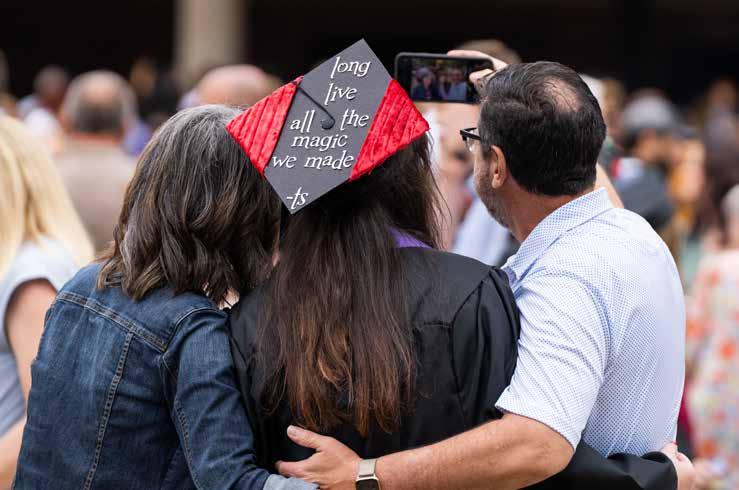
WHO GOT YOU THROUGH?
It might have been a professor who inspired and encouraged you. It could have been a staff member who oversaw your student job on campus. Maybe it was your mom.
Most of us have had mentors, people who helped get us through not just college, but maybe also our first job and subsequent life milestones.
So Bellarmine Magazine wants to know:
“Who was your Bellarmine mentor — who got you through?”
Send your story—and a photo, if you have one—to Editor-in-Chief Carla Carlton at letters@bellarmine.edu. We may use it in a future issue.
46 BELLARMINE MAGAZINE
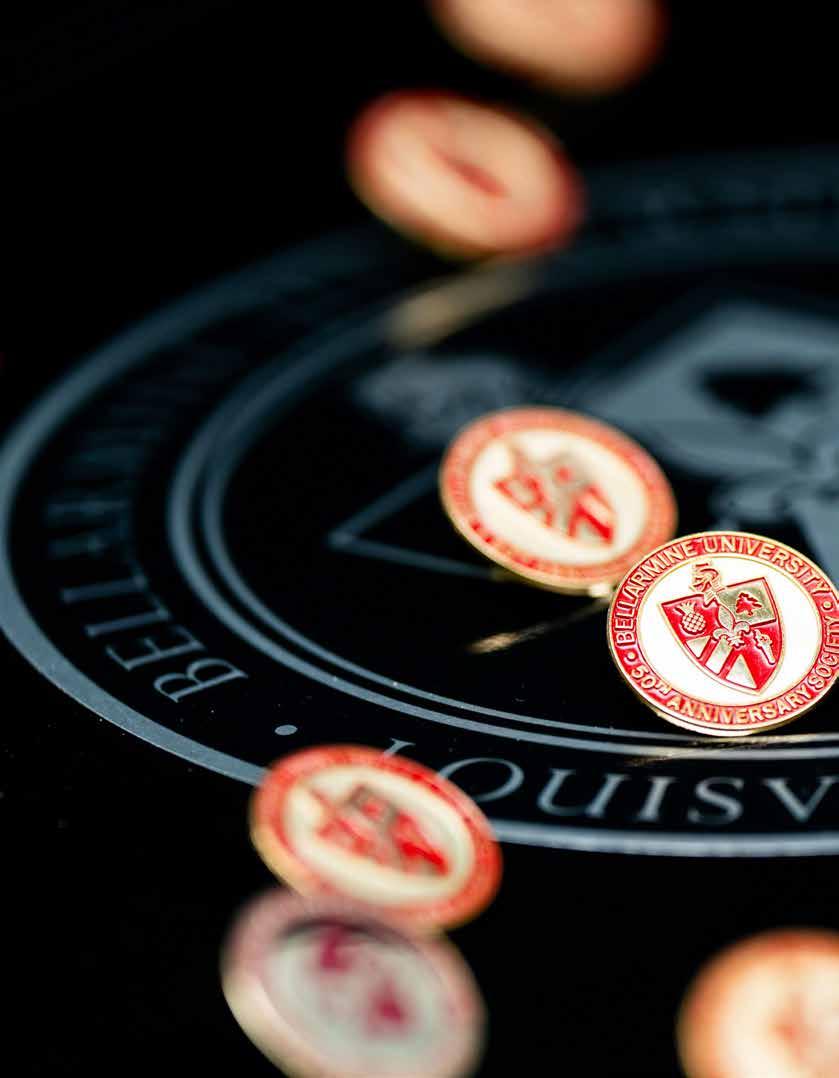
Alumni Weekend, Bellarmine’s annual reunion celebration and salute to graduates, will take place Sept. 6-8, 2024. Plan to join us for a memorable weekend filled with milestone reunions, including the Class of 1974’s 50th Reunion, and Brew at BU, our premier beer, wine and food festival. Learn more at alumni.bellarmine.edu.
SAVE the DATE
ALUMNI WEEKEND 2024!

See Page 16 for more.
“Watching Birbs Watch Me,” an acrylic painting by Kayla Bischoff ’14 from “La Crème de la Crème,” a show featuring artwork by students of Bob Lockhart.























 MAUREEN MCRAITH
MAUREEN MCRAITH







































 Kenai Fjords National Park in Alaska
Great Smoky Mountains National Park in North Carolina/Tennessee
Kenai Fjords National Park in Alaska
Great Smoky Mountains National Park in North Carolina/Tennessee


























